TANDBERG MPS 800, MPS 200 User Manual
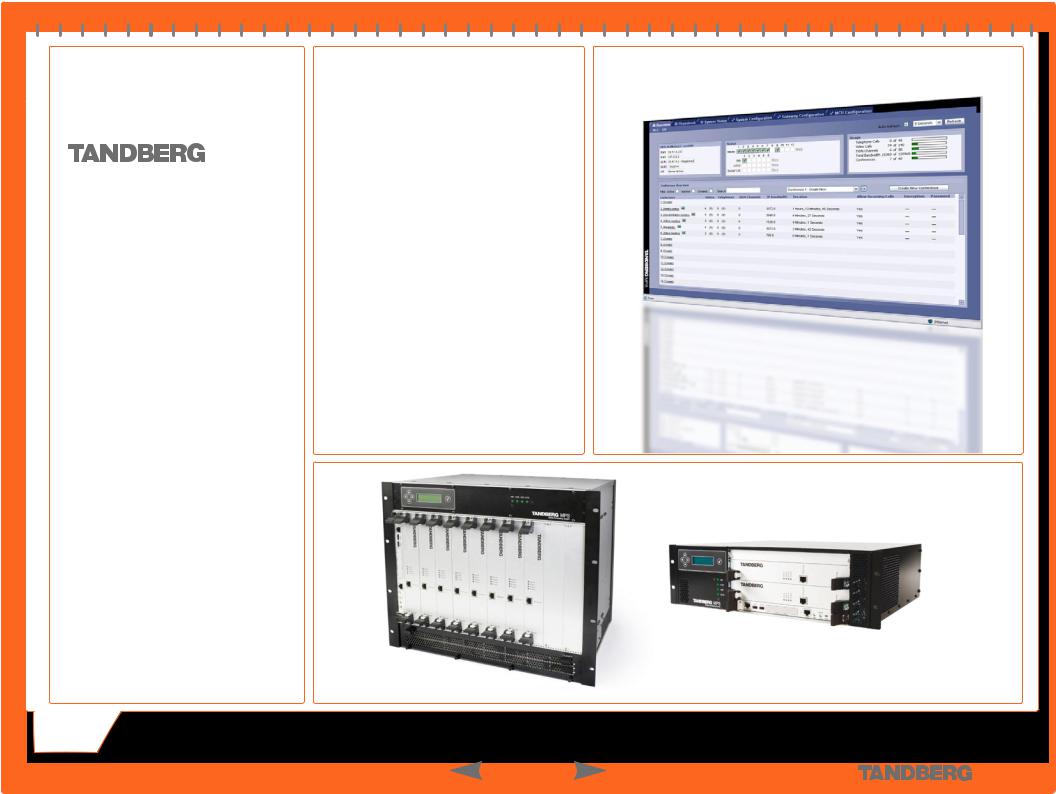
|
• Join up to 40/160 video and 32/48 audio sites |
|
in one or more conferences |
|
• 19” rack-mountable chassis with LCD in front |
|
and CompactPCI backplane |
|
• Wide range of network and protocol support: SIP, |
|
IP, ISDN and V.35 |
|
• Supports H.264 with Continuous Presence and |
MPS 200 |
Voice Switching |
• Modular and expandable with multiple media pro- |
|
cessing boards and network interface boards |
|
• Bandwidth: from 56 kbps–2 Mbps |
|
MPS 800 |
• Supports Simultaneous display of presenter and |
|
presentations, Dual Video Stream (DuoVideoTF, |
||
|
||
|
H.239 or BFCP) including PC presentations using |
|
|
VGA, SVGA and XGA resolutions |
|
|
• Simple to configure, Plug-and-Play technology |
|
|
• Supports network and video equipment from |
|
|
multiple vendors |
|
|
• Outbound, Inbound, and Caller ID password |
|
|
protection |
|
|
• Supports widescreen HD resolution (1280x720p) |
|
|
• Flexible design as MCU, Gateway or hybrid |
|
|
• Highest level of standards based embedded |
|
|
encryption |
|
|
• Supports TANDBERG ExpresswayTM firewall |
|
|
traversal, H.460.18 and H.460.19. |
Administrator
Guide
Software version J4.1
D13373.08
November 2007
Main |
Introduction |
Installation |
Quick |
Using |
System |
System |
Gateway |
MCU |
Technical |
Appendices |
|
Setup |
the MPS |
Status |
Configuration |
Configuration |
Configuration |
Descriptions |
|||||
|
|
|
|
||||||||
D 13373.08 |
|
|
|
|
1 |
|
|
|
|
MPS |
|
NOVEMBER 2007 |
|
|
|
|
|
|
|
|

MPS 200 MPS 800
We recommend that you check the TANDBERG web site regularly for updated versions of this manual:
http://www.tandberg.com/support/ documentation.php
Finding the Information You Need
Thank you for choosing TANDBERG! The TANDBERG MPS (Media Processing System) has been designed to provide you with many years of safe, reliable operation.
This Administrator Guide has been divided into several sections – each providing different information. In some places information has been copied from other sections so that all of the relevant information is present to eliminate unnecessary page scrolling
Note that the Administrator Guide describes a fully equipped version. Your version may not have all the described options installed.
Our main objective with this Administrator Guide is to address your goals and needs. Please let us know how well we succeeded!
Main |
Introduction |
Installation |
Quick |
Using |
System |
System |
Gateway |
MCU |
Technical |
Appendices |
|
Setup |
the MPS |
Status |
Configuration |
Configuration |
Configuration |
Descriptions |
|||||
|
|
|
|
||||||||
D 13373.08 |
|
|
|
|
2 |
|
|
|
|
MPS |
|
NOVEMBER 2007 |
|
|
|
|
|
|
|
|
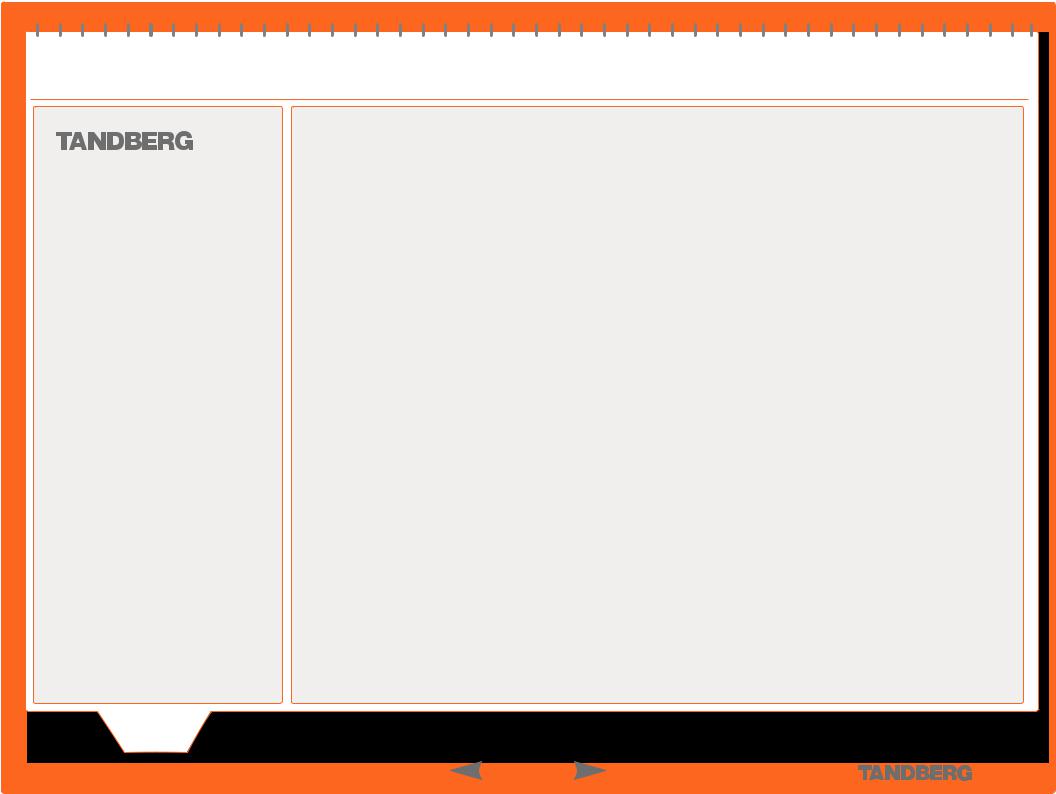
TANDBERG MPS ADMINISTRATOR GUIDE
MPS 200 MPS 800
Finding the Information You Need |
|
Introduction |
|
What’s New in this Version?................................................ |
6 |
Disclaimer, Patent Info, License Agreement, |
|
Trademark & Copyright........................................................ |
7 |
Third Party Software, Licenses and Copyright (1:6)............... |
8 |
Safety Instructions............................................................ |
14 |
Environmental Issues........................................................ |
15 |
Environmental Issues - RoHS Table.................................... |
16 |
Features Overview & MPS Capacity.................................... |
17 |
TANDBERG MPS at a Glance.............................................. |
18 |
Installation |
|
Precautions, Unpacking and Mounting............................... |
20 |
MPS 200 with 2 Media Processing Boards - Front Side....... |
21 |
MPS 200 with ISDN and V.35 Network Cards - Rear Side.... |
22 |
MPS 800 with 8 Media Processing Cards - Front Side......... |
23 |
MPS 800 with ISDN and V.35 Network Cards - Rear Side.... |
24 |
Connecting Cables............................................................ |
25 |
Starting the System.......................................................... |
26 |
LCD Menu Structure.......................................................... |
27 |
System Controller Board - Parameter Configuration............. |
28 |
Media Processing Board - Parameter Configuration............. |
29 |
Video Settings (1:5)...................................................... |
42 |
Audio Settings............................................................. |
47 |
Security Settings (1:2).................................................. |
48 |
Participants Settings.................................................... |
50 |
Network Settings.......................................................... |
51 |
MCU Overview > Manage an Active Conference.................. |
52 |
Conference Status (1:2)............................................... |
53 |
Add Participants (1:3)................................................... |
55 |
Add Participants - Examples......................................... |
58 |
Edit Conference Settings.............................................. |
59 |
Dial In Direct (DID)........................................................ |
60 |
The Basic View (1:3)..................................................... |
61 |
The Advanced View....................................................... |
64 |
The Terminal List View.................................................. |
65 |
The Change View.......................................................... |
66 |
Gateway Features and Capacity......................................... |
67 |
Gateway Usage Information............................................... |
68 |
Gateway Calls Overview..................................................... |
69 |
GW Overview > Manage a Gateway Call.............................. |
70 |
Disconnect a Call......................................................... |
70 |
Transfer a Call.............................................................. |
71 |
Using the Phone Book....................................................... |
72 |
Add New Entry.............................................................. |
73 |
Edit Entry..................................................................... |
74 |
Add New Group Entry.................................................... |
75 |
What’s in this Administrator Guide?
Quick Setup of the MPS |
|
User Interfaces for the MPS.............................................. |
31 |
Simple IP Configuration..................................................... |
32 |
Simple H.323 Configuration.............................................. |
33 |
Simple PRI Configuration................................................... |
34 |
Simple Dial In Configuration.............................................. |
35 |
Using the MPS |
|
MCU Usage Information.................................................... |
37 |
MCU Conference Overview................................................ |
38 |
MCU Overview > Create Conference................................... |
39 |
Conference Configuration (1:2)..................................... |
40 |
System Status |
|
ISDN PRI Board Status...................................................... |
77 |
G.703 Board Status.......................................................... |
78 |
Serial V.35 Board Status................................................... |
79 |
Media Board IP Status...................................................... |
80 |
H.323 Status.................................................................... |
81 |
SIP Status........................................................................ |
82 |
System Information (1:3)................................................... |
83 |
System Configuration |
|
H.320 Board..................................................................... |
87 |
Network Configuration.................................................. |
87 |
Main |
Table of |
Introduction |
Installation |
Quick |
Using |
System |
System |
Gateway |
MCU |
Technical |
Appendices |
|
Contents |
Setup |
the MPS |
Status |
Configuration |
Configuration |
Configuration |
Descriptions |
|||||
|
|
|
|
|||||||||
D 13373.08 |
|
|
|
|
|
3 |
|
|
|
|
MPS |
|
NOVEMBER 2007 |
|
|
|
|
|
|
|
|
|
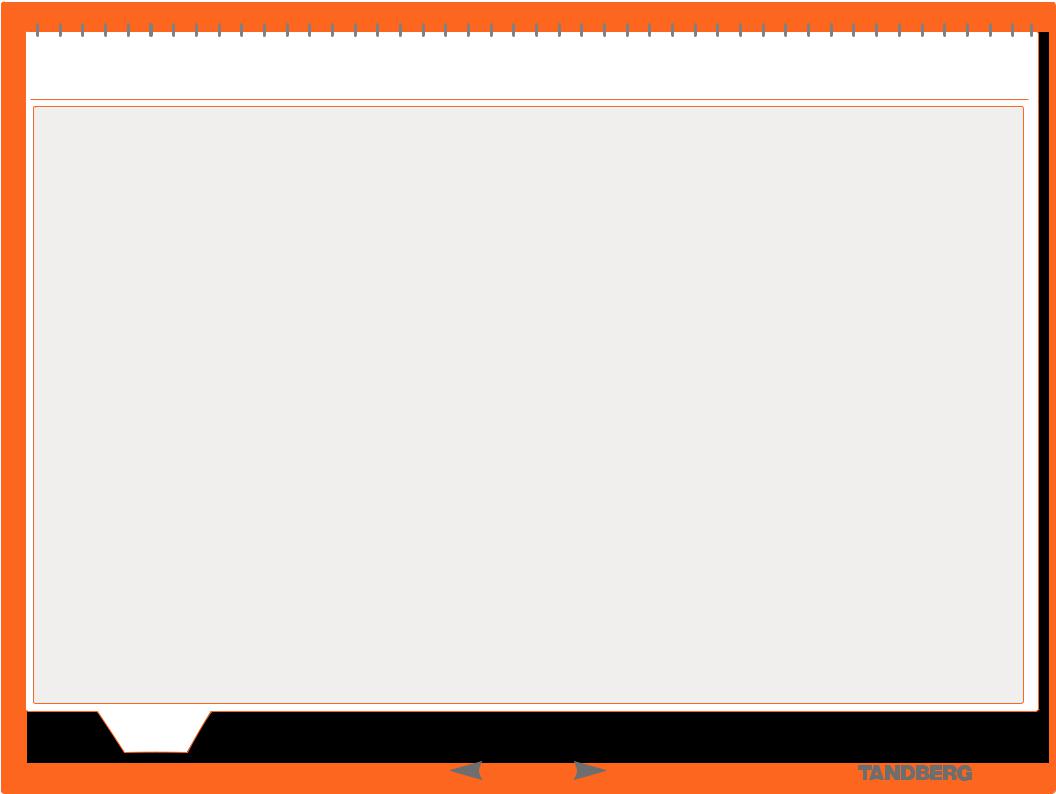
Table of Contents
TANDBERG MPS ADMINISTRATOR GUIDE
PRI Board......................................................................... |
|
|
88 |
PRI Board in Slot 1-n (1:3)............................................ |
|
88 |
|
PRI Interfaces (1:3)...................................................... |
|
91 |
|
E1/T1 Interfaces......................................................... |
|
94 |
|
G.703 Board..................................................................... |
|
|
95 |
G.703 Board Interfaces (1:2)........................................ |
|
95 |
|
IP Board........................................................................... |
|
|
97 |
IP Interfaces Configuration........................................... |
|
97 |
|
DNS Interfaces, IP Services......................................... |
|
98 |
|
Media Board IP Configuration............................................ |
|
99 |
|
Serial V.35 Board Interfaces........................................... |
|
100 |
|
H.323 Configuration....................................................... |
|
101 |
|
Gatekeeper Settings, Net 1-2..................................... |
|
101 |
|
SNMP Configuration....................................................... |
|
102 |
|
SIP Configuration |
............................................................ |
|
103 |
QoS Configuration.......................................................... |
|
104 |
|
Miscellaneous Configuration........................................... |
|
105 |
|
Language....................................................................... |
|
|
107 |
Set Language. |
........................................................... |
|
107 |
Dialog Pictures.......................................................... |
|
108 |
|
Dialog Sounds, Symbols............................................ |
|
109 |
|
XML Document............................................................... |
|
|
110 |
Certificate Management................................................. |
|
111 |
|
Gateway Configuration |
|
|
|
Gateway Functionality and Dialling Rules......................... |
113 |
||
Dialling Rules................................................................. |
|
|
114 |
Examples with ISDN Gateway..................................... |
|
115 |
|
Examples with V.35 Gateway...................................... |
|
116 |
|
Examples with G.703 Gateway.................................... |
|
117 |
|
Gateway Configuration (1:3)............................................ |
|
118 |
|
File Management............................................................ |
|
|
121 |
MCU Configuration |
|
|
|
About the Dial In Numbers Menu..................................... |
|
123 |
|
Single Dial In Number Menu....................................... |
|
124 |
|
Ad Hoc Conferences Menu......................................... |
|
125 |
|
Static Conferences Menu........................................... |
|
126 |
|
Personal Conferences Menu....................................... |
|
127 |
|
Personal Conferences Menu....................................... |
|
128 |
|
Direct Ad Hoc Conferences Menu............................... |
129 |
||
Network Profiles............................................................. |
|
|
130 |
Conference Template...................................................... |
|
131 |
|
Conference Configuration (1:2)................................... |
|
131 |
|
|
Table of |
|
|
Main |
|
Introduction |
Installation |
|
Contents |
|
|
D 13373.08 |
|
|
|
NOVEMBER 2007 |
|
|
|
Video Settings (1:5)................................................... |
133 |
Audio Settings........................................................... |
138 |
Security Settings (1:2)............................................... |
139 |
Participants Settings................................................. |
141 |
Network Settings....................................................... |
142 |
File Management (1:2).................................................... |
143 |
Product Approvals and Declarations................................ |
171 |
Product Approvals...................................................... |
171 |
CE Declarations......................................................... |
171 |
A Class Product Declaration....................................... |
171 |
SIP - Current RFC’s and Drafts Supported........................ |
172 |
Configuring LCS and MPS for SIP (1:6)............................. |
173 |
Technical Descriptions
Network Interfaces......................................................... |
146 |
System Controller Board Interface.............................. |
146 |
Media Processing Board Interface.............................. |
147 |
E1/T1 Network Interface Card (IIC-8) (1:3).................. |
148 |
V.35 Serial Interface Card (SIC-32)............................. |
151 |
V.35 Serial Interface Card - Cable Description............. |
152 |
Power Supplies.......................................................... |
153 |
MPS 800 - Inserting Network Interface Cards.............. |
154 |
MPS 200 - Inserting Network Interface Cards.............. |
155 |
Features........................................................................ |
156 |
Quality of Service (QoS)............................................. |
156 |
TANDBERG Best ImpressionTF .................................... |
157 |
4CIF Digital ClarityTF, H.263, H.263+........................... |
158 |
DuoVideoTF, H.239, BFCP............................................ |
158 |
H.264....................................................................... |
158 |
Optimal Voice Switch................................................. |
158 |
IP Adaptive Bandwidth Management........................... |
159 |
Flow Control (DownspeedingTF).................................... |
159 |
Asymmetrical Encoders and Decoders........................ |
159 |
LipSync..................................................................... |
159 |
Latency and Jitter...................................................... |
159 |
Intelligent Packet Loss Recovery................................. |
160 |
Inband Changing of Video and Audio Algorithms.......... |
160 |
Transcoding and Ratematching................................... |
160 |
Distributed MCUs...................................................... |
161 |
Miscellaneous................................................................ |
162 |
Ports and Packet Sizes.............................................. |
162 |
Secure Conference (Encryption).................................. |
163 |
System Management Tools........................................ |
164 |
System Management and Security.............................. |
165 |
Appendices
Technical Specifications. |
................................................ |
|
167 |
|
|
|
|
||
TANDBERG MPS 200 |
(1:2).......................................... |
|
167 |
|
|
|
|
||
TANDBERG MPS 800 |
(1:2).......................................... |
|
169 |
|
|
|
|
||
Quick |
Using |
System |
System |
Gateway |
MCU |
Technical |
Appendices |
||
Setup |
the MPS |
Status |
Configuration |
Configuration |
Configuration |
Descriptions |
|||
|
|||||||||
|
|
|
4 |
|
|
|
|
MPS |
|
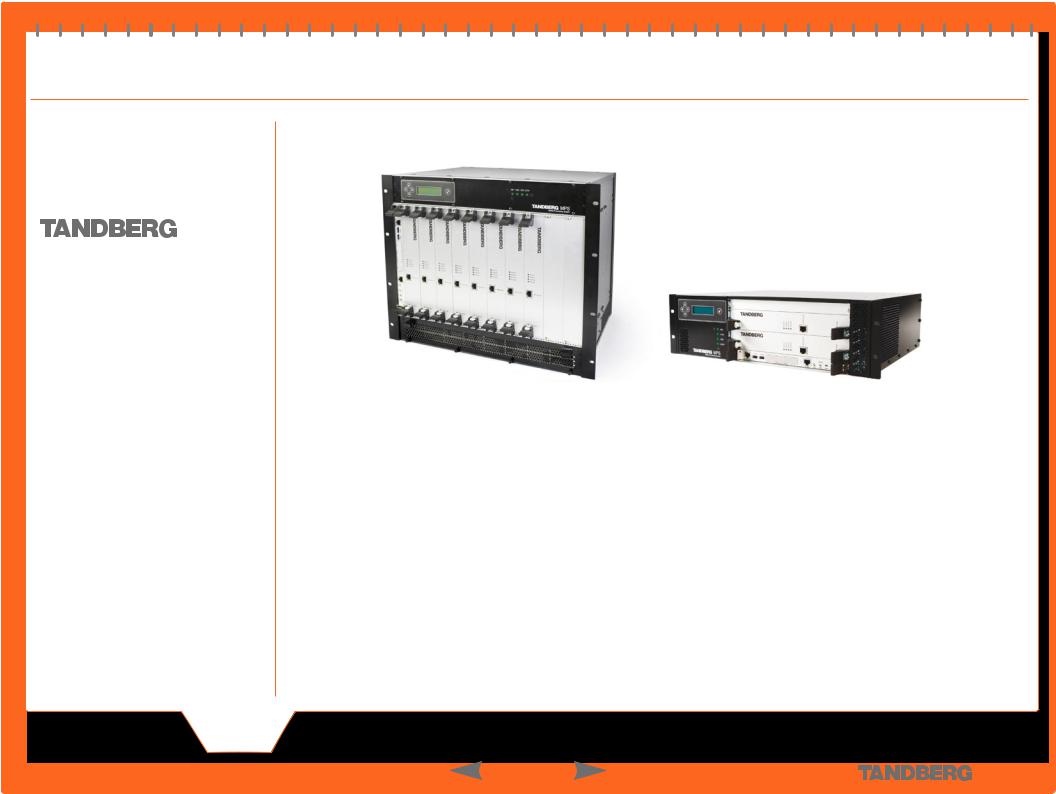
TANDBERG MPS ADMINISTRATOR GUIDE
MPS 200 MPS 800
We recommend that you check out the TANDBERG web site regularly for updated versions of this manual:
http://www.tandberg.com/support/ documentation.php
Introduction
The TANDBERG MPS enables sites on IP (H.323 and SIP), ISDN and High Speed Serial (V.35/RS449/RS530 w/RS366 support) to participate in meetings with each other and offers superior quality and ease of use in one fully-featured multipoint control unit, MCU.
Main |
Introduction |
Installation |
Quick |
Using |
System |
System |
Gateway |
MCU |
Technical |
Appendices |
|
Setup |
the MPS |
Status |
Configuration |
Configuration |
Configuration |
Descriptions |
|||||
|
|
|
|
||||||||
D 13373.08 |
|
|
|
|
5 |
|
|
|
|
MPS |
|
NOVEMBER 2007 |
|
|
|
|
|
|
|
|
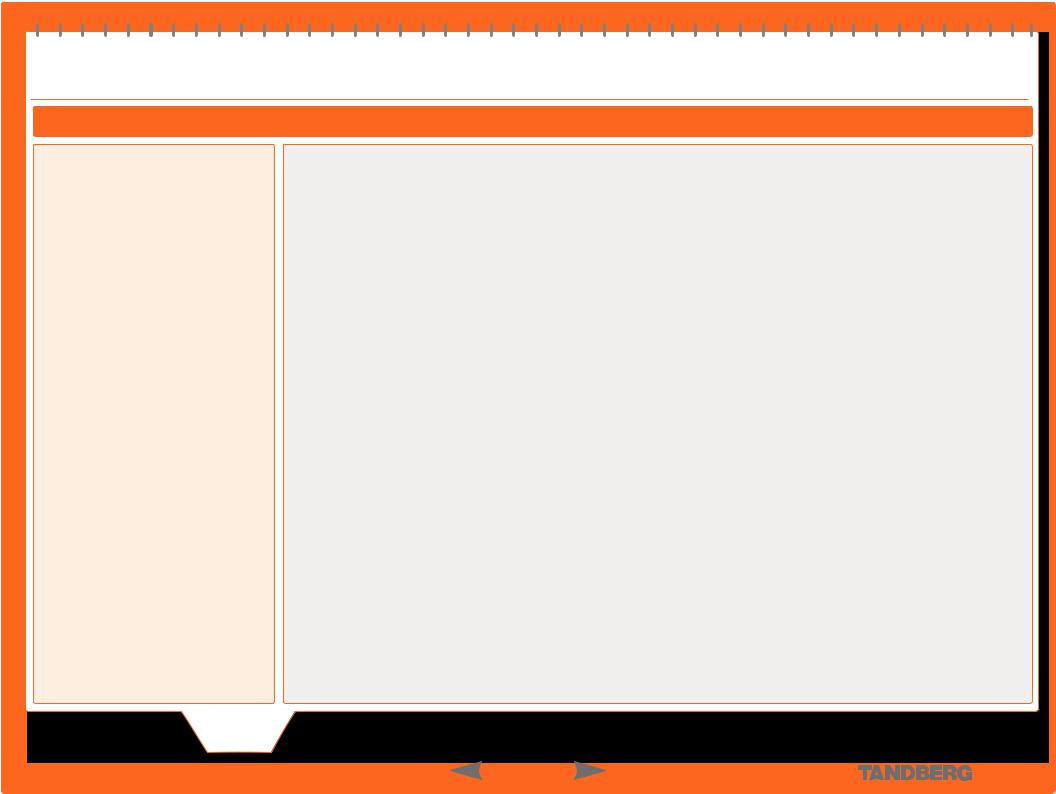
Introduction
What’s New in this Version?
Version J4 of the TANDBERG MPS provides several new capabilities and enhancements. For your convenience a list of them is provided here.
New Features in Version J4
IPv6 Enabled
• IPv6/IPv4 Dual Stack
Enhanced SIP Features
•Dual Video Stream
•Early media
•Floor control
•Feature parity to TANDBERG Video Systems with software version F5/F6
•Transfer, Forward and Hold support
Gateway Support for OD/HD
•H.264 w288p, 400p, w448p, w576p, w720p
•H.263 w288p, 400p, w488p, w576p
Video
•Decode w288p
•Consistent layouts for 16:9 and 4:3
•Up to 32 sites in Continuous Presence
Web Interface
• Improved Layout Lock in the web interface
Conferencing
•Direct Ad Hoc Conferences
•Ten conference prefixes with individual templates
•Auto Dial Out on Personal Conferences
•Dynamic allocation of ports for Ad Hoc Conferences
•Waiting room provided to attendees prior to conference start.
•Access to all conference types through Single Number Dial In (SNDI).
•Requires E.164 alias on conference
TANDBERG MPS ADMINISTRATOR GUIDE
Main |
Introduction |
Installation |
Quick |
Using |
System |
System |
Gateway |
MCU |
Technical |
Appendices |
|
Setup |
the MPS |
Status |
Configuration |
Configuration |
Configuration |
Descriptions |
|||||
|
|
|
|
||||||||
D 13373.08 |
|
|
|
|
6 |
|
|
|
|
MPS |
|
NOVEMBER 2007 |
|
|
|
|
|
|
|
|
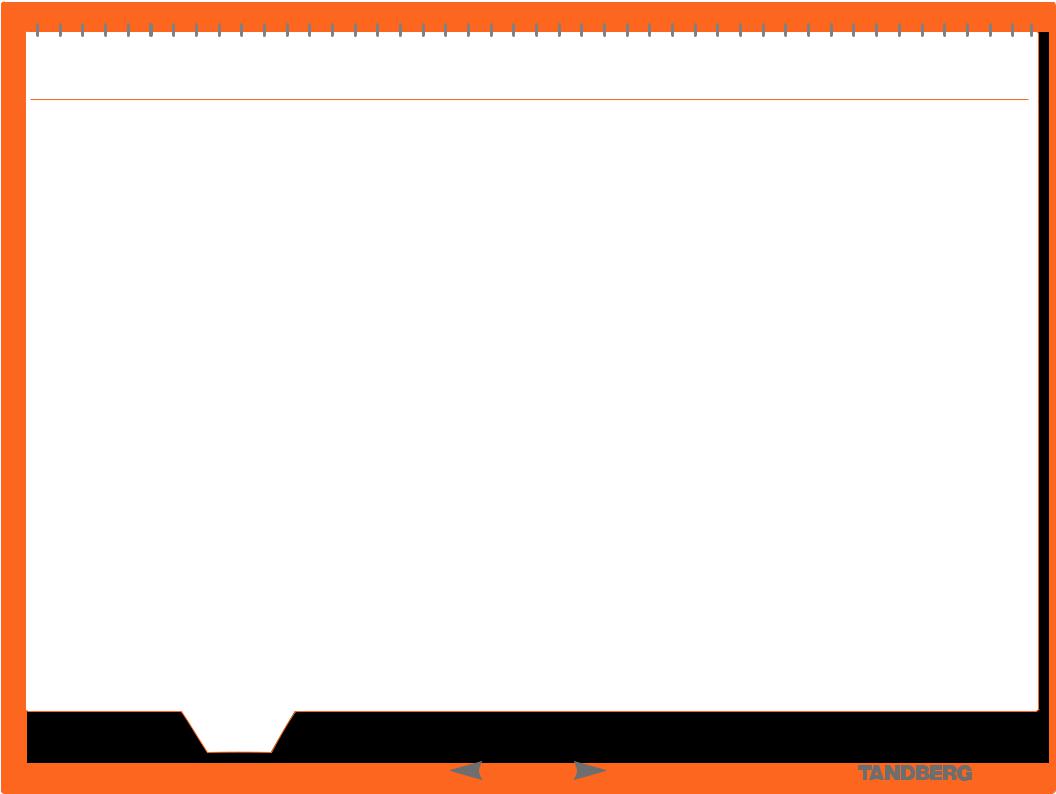
Introduction
Disclaimer, Patent Info, License Agreement, Trademark & Copyright
TANDBERG MPS ADMINISTRATOR GUIDE
Disclaimer
The information in this document is furnished for informational purposes only, is subject to change without prior notice, and should not be construed as a commitment by TANDBERG.
The information in this document is believed to be accurate and reliable; however TANDBERG assumes no responsibility or liability for any errors or inaccuracies that may appear in this document, nor for any infringements of patents or other rights of third parties resulting from its use. No license is granted under any patents or patent rights of TANDBERG.
This document was written by the Research and Development Department of TANDBERG, Norway. We are committed to maintain a high level of quality in all our documentation. Towards this effort, we welcome you to Contact us with comments and suggestions regarding the content and structure of this document.
Patent information
The products described in this manual are covered by one or more of the following patents:
US6,584,077 |
US5,838,664 |
US5,600,646 |
US5,768,263 |
US5,991,277 |
US7,034,860 |
US7.283.588 |
EP01953201 |
GB1338127 |
Other patents pending.
License Agreement
All rights reserved. This document contains information that is proprietary to TANDBERG. No part of this publication may be reproduced, stored in a retrieval system, or transmitted, in any form, or by any means, electronically, mechanically, by photocopying, or otherwise, without the prior written permission of TANDBERG. Nationally and internationally recognized trademarks and trade names are the property of their respective holders and are hereby acknowledged.
Trademark and Copyright
Copyright © 2005–2007 TANDBERG. All rights reserved. TANDBERG is a registered trademark of TANDBERG ASA and/or its subsidiaries in the United States and/or other countries.
Main |
Introduction |
Installation |
D 13373.08
NOVEMBER 2007
Quick |
Using |
System |
System |
Gateway |
MCU |
Technical |
Appendices |
|
Setup |
the MPS |
Status |
Configuration |
Configuration |
Configuration |
Descriptions |
||
|
||||||||
|
|
7 |
|
|
|
|
MPS |
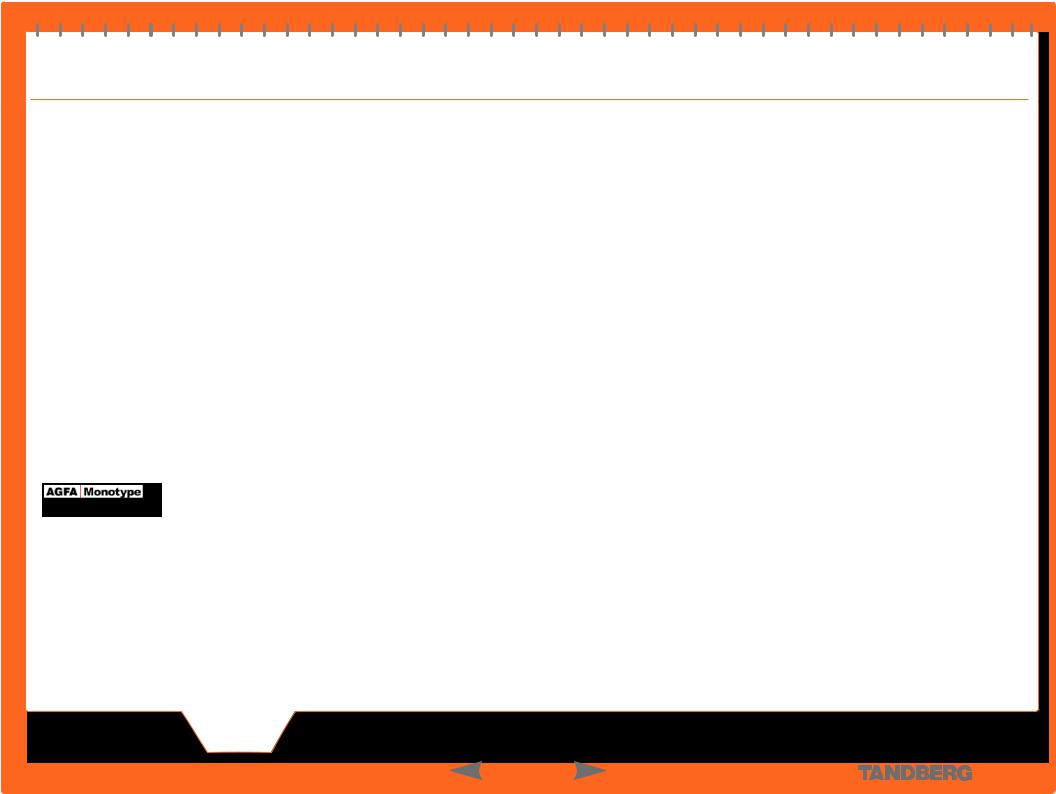
Introduction
Third Party Software, Licenses and Copyright (1:6)
TANDBERG MPS ADMINISTRATOR GUIDE
Third Party Software
Amended / Expanded Copyright notices for thirdparty software on the TANDBERG MPS systems are listed below:
Full copies of the licenses and warranty statements are located on the product CD in the license files directory.
The non-commercial third party code is distributed in binary form under the terms of non-copyleft style open source licenses such as BSD, Artistic or MIT/X Consortium.
The product also has some binary code distributed under the terms of the GNU public license with an exemption which allows static links to non-copyleft commercial code.
In accordance with section (3) of the GNU General Public License, copies of such code will be provided upon request by contacting TANDBERG. Please contact us by using the Online Support section at www.tandberg.com or the “contact us” section of this manual. Please provide USD 10.00 for media and shipping.
Agfa
Contains iType™ from Agfa Monotype Corporation.
eCos
eCos, the Embedded Configurable Operating System.
Copyright (C) 1998, 1999, 2000, 2001, 2002, 2003 Red Hat, Inc.
Copyright (C) 2002, 2003 John Dallaway
Copyright (C) 2002, 2003 Nick Garnett
Copyright (C) 2002, 2003 Jonathan Larmour Copyright (C) 2002, 2003 Andrew Lunn Copyright (C) 2002, 2003 Gary Thomas Copyright (C) 2002, 2003 Bart Veer
Copyright (c) 1982, 1986, 1991, 1993 The Regents of the University of California. All rights reserved.
(c) UNIX System Laboratories, Inc.
All or some portions of this file are derived from material licensed to the University of California by American Telephone and Telegraph Co. or Unix System Laboratories, Inc. and are reproduced herein with the permission of UNIX System Laboratories, Inc.
Copyright (C) 1995, 1996, 1997, and 1998 WIDE Project. * All rights reserved.
Copyright (c) 2000 Brian Somers <brian@Awfulhak. org>
Copyright (c) 1998 The NetBSD Foundation, Inc. * All rights reserved.
Copyright (c) 1997 Niklas Hallqvist. All rights reserved.
Copyright (c) 1988 Stephen Deering.
Copyright (c) 1992, 1993 The Regents of the University of California. All rights reserved.
This code is derived from software contributed to Berkeley by Stephen Deering of Stanford University.
Portions of eCos code are distributed under several BSD style licenses. Other portions of eCos code are distributed under the terms of the GNU General Public License with a non-copyleft exception which allows static links to non -copyleftprograms.
ExPat XML Parser:
Copyright (c) 1998, 1999, 2000 Thai Open Source Software Center Ltd and Clark Cooper
Copyright (c) 2001, 2002, 2003, 2004, 2005, 2006 Expat maintainers.
The ExPat XML parser is distributed under the terms of the ExPat License which is a MIT/X Consortium style open source license
ICU
ICU License - ICU 1.8.1 Copyright (c) 1995-2003 International Business Machines Corporation and others All rights reserved.
ICU is distributed under the terms of the ICU license, which is a MIT/X Consortium style license.
LICENSE FOR Miscellaneous GPL-licensed software
This TANDBERG product contains software from various third-party vendors which is licensed under the GNU General Public License (GNU GPL).
The list of GPL-licensed software includes (but is not limited to) The Linux kernel, Busybox, and PAM.
The full text of the GNU General Public License may be viewed at http://www.gnu.org/licenses/gpl.html
LICENSE FOR OpenSSL LICENSE ISSUES
The OpenSSL toolkit stays under a dual license, i.e. both the conditions of the OpenSSL License and the original SSLeay license apply to the toolkit. See below for the actual license texts. Actually both licenses are BSD-style Open Source licenses. In case of any license issues related to OpenSSL please contact openssl-core@openssl.org.
OpenSSL License
Copyright (c) 1998-2004 The OpenSSL Project. All rights reserved. Redistribution and use in source and binary forms, with or without modification, are permitted provided that the following conditions are met:
1.Redistributions of source code must retain the above copyright notice, this list of conditions and the following disclaimer.
2.Redistributions in binary form must reproduce the above copyright notice, this list of conditions and the following disclaimer in the documentation and/or other materials provided with the distribution.
3.All advertising materials mentioning features or use of this software must display the following acknowledgment: “This product includes software developed by the OpenSSL Project for use in the OpenSSL Toolkit. (http://www.openssl.org/)”
4.The names “OpenSSL Toolkit” and “OpenSSL Project” must not be used to endorse or promote products derived from this software without
prior written permission. For written permission, please contact openssl-core@openssl.org.
5.Products derived from this software may not be called “OpenSSL” nor may “OpenSSL” appear in their names without prior written permission of the OpenSSL Project.
6.Redistributions of any form whatsoever must retain the following acknowledgment: “This product includes software developed by the OpenSSL Project for use in the OpenSSL Toolkit (http:// www.openssl.org/)”
THIS SOFTWARE IS PROVIDED BY THE OpenSSL PROJECT ”AS IS” AND ANY EXPRESSED OR IMPLIED WARRANTIES, INCLUDING, BUT NOT LIMITED TO, THE IMPLIED WARRANTIES OF MERCHANTABILITY AND FITNESS FOR A PARTICULAR PURPOSE ARE DISCLAIMED. IN NO EVENT SHALL THE OpenSSL PROJECT OR ITS CONTRIBUTORS BE LIABLE FOR ANY DIRECT, INDIRECT, INCIDENTAL, SPECIAL, EXEMPLARY, OR CONSEQUENTIAL DAMAGES (INCLUDING, BUT NOT LIMITED TO, PROCUREMENT OF SUBSTITUTE GOODS OR SERVICES; LOSS OF USE, DATA, OR PROFITS; OR BUSINESS INTERRUPTION) HOW-
EVER CAUSED AND ON ANY THEORY OF LIABILITY, WHETHER IN CONTRACT, STRICT LIABILITY, OR TORT (INCLUDING NEGLIGENCE OR OTHERWISE) ARISING IN ANY WAY OUT OF THE USE OF THIS SOFTWARE, EVEN IF ADVISED OF THE POSSIBILITY OF SUCH DAMAGE.
This product includes cryptographic software written by Eric Young (eay@cryptsoft.com).
This product includes software written by Tim Hudson (tjh@cryptsoft.com).
Original SSLeay License
Copyright (C) 1995-1998 Eric Young (eay@cryptsoft. com). All rights reserved.
This package is an SSL implementation written by Eric Young (eay@cryptsoft.com).
The implementation was written so as to conform
Main |
Introduction |
Installation |
Quick |
Using |
System |
System |
Gateway |
MCU |
Technical |
Appendices |
|
Setup |
the MPS |
Status |
Configuration |
Configuration |
Configuration |
Descriptions |
|||||
|
|
|
|
||||||||
D 13373.08 |
|
|
|
|
8 |
|
|
|
|
MPS |
|
NOVEMBER 2007 |
|
|
|
|
|
|
|
|
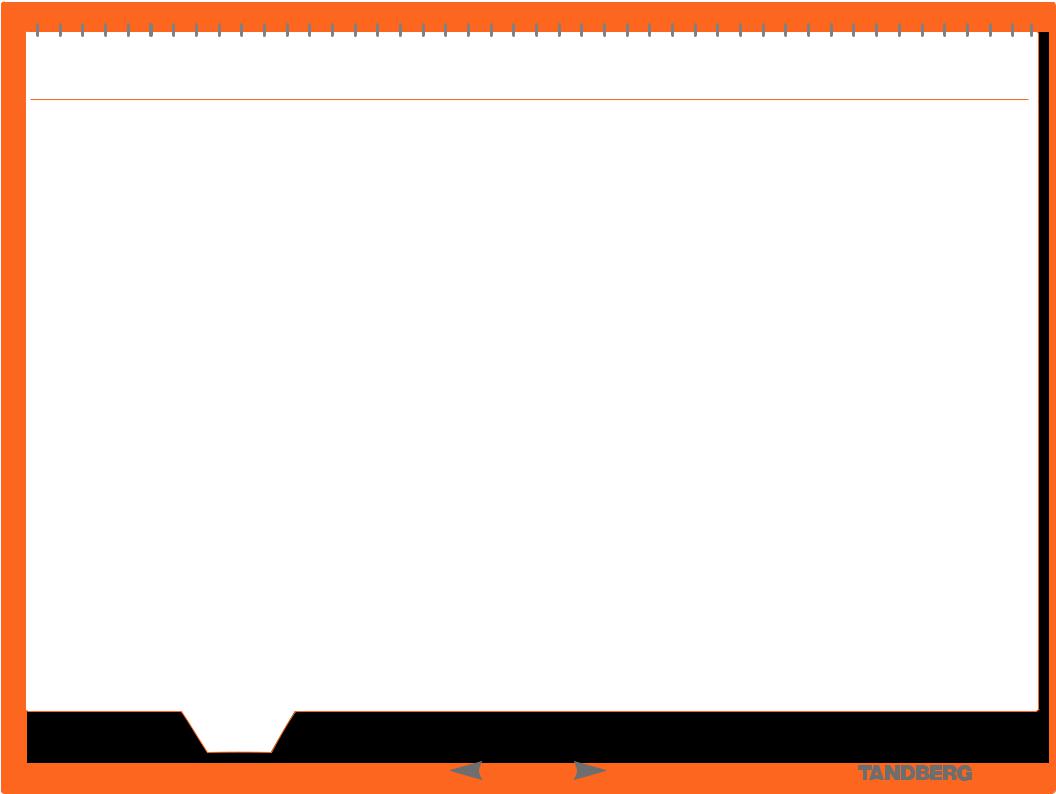
Introduction
Third Party Software, Licenses and Copyright (2:6)
TANDBERG MPS ADMINISTRATOR GUIDE
with Netscapes SSL.
This library is free for commercial and non-com- mercial use as long as the following conditions are aheared to. The following conditions apply to all code found in this distribution, be it the RC4, RSA, lhash, DES, etc., code; not just the SSL code. The SSL documentation included with this distribution is covered by the same copyright terms except that the holder is Tim Hudson (tjh@cryptsoft.com).
Copyright remains Eric Young’s, and as such any Copyright notices in the code are not to be removed.
If this package is used in a product, Eric Young should be given attribution as the author of the parts of the library used.
This can be in the form of a textual message at program startup or in documentation (online or textual) provided with the package.
Redistribution and use in source and binary forms, with or without modification, are permitted provided that the following conditions are met:
1.Redistributions of source code must retain the copyright notice, this list of conditions and the following disclaimer.
2.Redistributions in binary form must reproduce the above copyright notice, this list of conditions and the following disclaimer in the documentation and/or other materials provided with the distribution.
3.All advertising materials mentioning features or use of this software must display the following acknowledgement: “This product includes cryptographic software written by Eric Young (eay@ cryptsoft.com)”. The word ‘cryptographic’ can be left out if the rouines from the library being used are not cryptographic related :-).
4.If you include any Windows specific code (or a derivative thereof) from the apps directory (application code) you must include an acknowledgement: “This product includes software written by Tim Hudson (tjh@cryptsoft.com)”
THIS SOFTWARE IS PROVIDED BY ERIC YOUNG “AS IS” AND ANY EXPRESS OR IMPLIED WARRANTIES, INCLUDING, BUT NOT LIMITED TO, THE IMPLIED WARRANTIES OF MERCHANTABILITY AND FITNESS FOR A PARTICULAR PURPOSE ARE DISCLAIMED. IN NO EVENT SHALL THE AUTHOR OR CONTRIBUTORS BE LIABLE FOR ANY DIRECT, INDIRECT, INCIDENTAL, SPECIAL, EXEMPLARY, OR CONSEQUENTIAL DAMAGES (INCLUDING, BUT NOT LIMITED TO, PROCUREMENT OF SUBSTITUTE GOODS OR SERVICES; LOSS OF USE, DATA, OR PROFITS; OR BUSINESS INTERRUPTION) HOWEVER CAUSED AND ON ANY THEORY OF LIABILITY, WHETHER IN CONTRACT, STRICT LIABILITY, OR TORT (INCLUDING NEGLIGENCE OR OTHERWISE) ARISING IN ANY WAY OUT OF THE USE OF THIS SOFTWARE, EVEN IF ADVISED OF THE POSSIBILITY OF SUCH DAMAGE.
The licence and distribution terms for any publically available version or derivative of this code cannot be changed. i.e. this code cannot simply be copied and put under another distribution licence [including the GNU Public Licence.]
LICENSE FOR openssh
The licences which components of this software fall under are as follows. First, we will summarize and say that all components are under a BSD licence, or a licence more free than that.
OpenSSH contains no GPL code. Part 1
Copyright (c) 1995 Tatu Ylonen <ylo@cs.hut.fi>, Espoo, Finland. All rights reserved
As far as I am concerned, the code I have written for this software can be used freely for any purpose. Any derived versions of this software must be clearly marked as such, and if the derived work is incompatible with the protocol description in the RFC file, it must be called by a name other than “ssh” or “Secure Shell”. However, I am not implying to give any
licenses to any patents or copyrights held by third parties, and the software includes parts that are not under my direct control. As far as I know, all included source code is used in accordance with the relevant license agreements and can be used freely for any purpose (the GNU license being the most restrictive); see below for details.
However, none of that term is relevant at this point in time. All of these restrictively licenced software components which he talks about have been removed from OpenSSH, i.e.,
•RSA is no longer included, found in the OpenSSL library
•IDEA is no longer included, its use is deprecated
•DES is now external, in the OpenSSL library
•GMP is no longer used, and instead we call BN code from OpenSSL
•Zlib is now external, in a library
•The make-ssh-known-hosts script is no longer included
•TSS has been removed
•MD5 is now external, in the OpenSSL library
•RC4 support has been replaced with ARC4 support from OpenSSL
•Blowfish is now external, in the OpenSSL library
Note that any information and cryptographic algorithms used in this software are publicly available on the Internet and at any major bookstore, scientific library, and patent office worldwide. More information can be found e.g. at “http://www.cs.hut.fi/crypto”. The legal status of this program is some combination of all these permissions and restrictions. Use only at your own responsibility. You will be responsible
for any legal consequences yourself; I am not making any claims whether possessing or using this is legal or not in your country, and I am not taking any responsibility on your behalf.
NO WARRANTY
BECAUSE THE PROGRAM IS LICENSED FREE OF CHARGE, THERE IS NO WARRANTY FOR THE PRO-
GRAM, TO THE EXTENT PERMITTED BY APPLICABLE LAW. EXCEPT WHEN OTHERWISE STATED IN WRITING THE COPYRIGHT HOLDERS AND/OR OTHER PARTIES PROVIDE THE PROGRAM “AS IS” WITHOUT WARRANTY OF ANY KIND, EITHER EXPRESSED OR IMPLIED, INCLUDING, BUT NOT LIMITED TO, THE IMPLIED WARRANTIES OF MERCHANTABILITY AND FITNESS FOR A PARTICULAR PURPOSE. THE ENTIRE RISK AS TO THE QUALITY AND PERFORMANCE
OF THE PROGRAM IS WITH YOU. SHOULD THE PROGRAM PROVE DEFECTIVE, YOU ASSUME THE COST OF ALL NECESSARY SERVICING, REPAIR OR CORRECTION.
IN NO EVENT UNLESS REQUIRED BY APPLICABLE LAW OR AGREED TO IN WRITING WILL ANY COPYRIGHT HOLDER, OR ANY OTHER PARTY WHO MAY MODIFY AND/OR REDISTRIBUTE THE PROGRAM AS PERMITTED ABOVE, BE LIABLE TO YOU FOR DAMAGES, INCLUDING ANY GENERAL, SPECIAL, INCIDENTAL OR CONSEQUENTIAL DAMAGES ARISING OUT OF THE USE OR INABILITY TO USE THE PROGRAM (INCLUDING BUT NOT LIMITED TO LOSS OF DATA OR DATA BEING RENDERED INACCURATE OR LOSSES SUSTAINED BY YOU OR THIRD PARTIES OR A FAILURE OF THE PROGRAM TO OPERATE WITH
ANY OTHER PROGRAMS), EVEN IF SUCH HOLDER OR OTHER PARTY HAS BEEN ADVISED OF THE POSSIBILITY OF SUCH DAMAGES.
Part 2
The 32-bit CRC compensation attack detector in deattack.c was contributed by CORE SDI S.A. under a BSD-style license.
Cryptographic attack detector for ssh - source code Copyright (c) 1998 CORE SDI S.A., Buenos Aires, Argentina.
All rights reserved. Redistribution and use in source and binary forms, with or without modification, are permitted provided that this copyright notice is retained.
THIS SOFTWARE IS PROVIDED “AS IS” AND ANY EXPRESS OR IMPLIED WARRANTIES ARE DISCLAIMED. IN NO EVENT SHALL CORE SDI S.A. BE LIABLE FOR
Main |
Introduction |
Installation |
Quick |
Using |
System |
System |
Gateway |
MCU |
Technical |
Appendices |
|
Setup |
the MPS |
Status |
Configuration |
Configuration |
Configuration |
Descriptions |
|||||
|
|
|
|
||||||||
D 13373.08 |
|
|
|
|
9 |
|
|
|
|
MPS |
|
NOVEMBER 2007 |
|
|
|
|
|
|
|
|
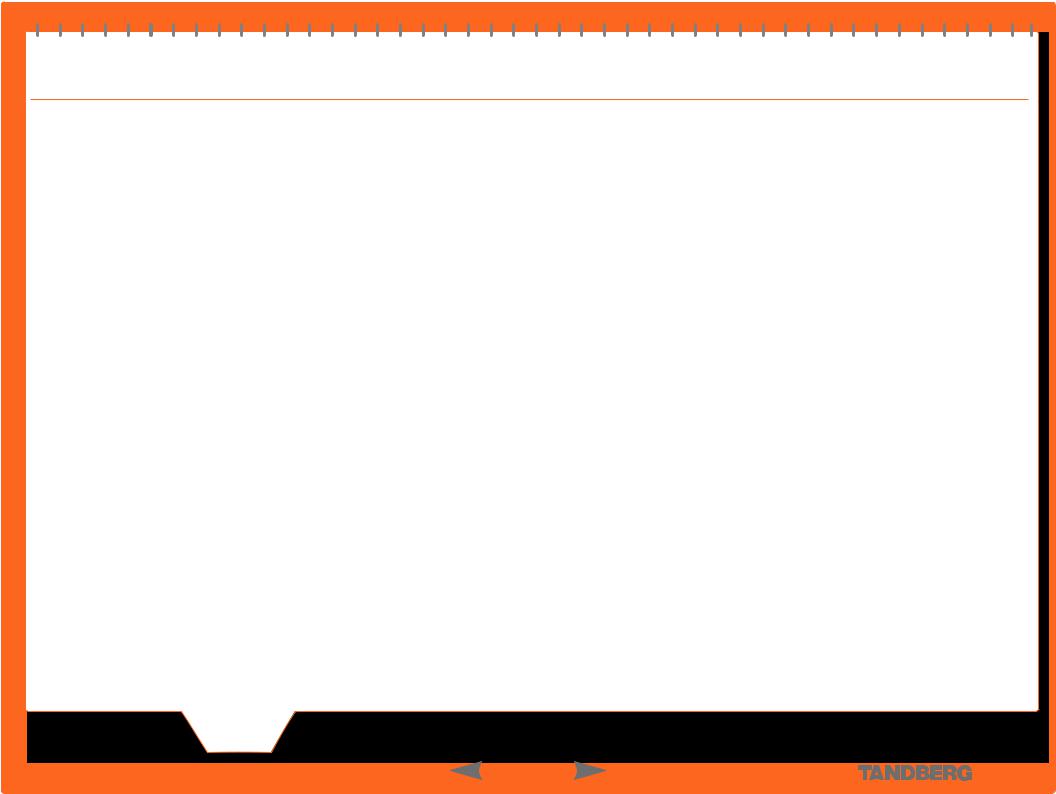
Introduction
Third Party Software, Licenses and Copyright (3:6)
TANDBERG MPS ADMINISTRATOR GUIDE
ANY DIRECT, INDIRECT, INCIDENTAL, SPECIAL, EXEMPLARY OR CONSEQUENTIAL DAMAGES RESULTING FROM THE USE OR MISUSE OF THIS SOFTWARE.
Ariel Futoransky <futo@core-sdi.com> <http://www.core-sdi.com>
Part 3
ssh-keygen was contributed by David Mazieres under a BSD-style license.
Copyright 1995, 1996 by David Mazieres <dm@lcs. mit.edu>.
Modification and redistribution in source and binary forms is permitted provided that due credit is given to the author and the OpenBSD project by leaving this copyright notice intact.
Part 4
The Rijndael implementation by Vincent Rijmen, Antoon Bosselaers and Paulo Barreto is in the public domain and distributed with the following license: @version 3.0 (December 2000)
Optimised ANSI C code for the Rijndael cipher (now AES)
@author Vincent Rijmen <vincent.rijmen@esat. kuleuven.ac.be>
@author Antoon Bosselaers <antoon.bosselaers@ esat.kuleuven.ac.be>
@author Paulo Barreto <paulo.barreto@terra.com.br>
This code is hereby placed in the public domain.
THIS SOFTWARE IS PROVIDED BY THE AUTHORS “AS IS” AND ANY EXPRESS OR IMPLIED WARRANTIES, INCLUDING, BUT NOT LIMITED TO, THE IMPLIED WARRANTIES OF MERCHANTABILITY AND FITNESS FOR A PARTICULAR PURPOSE ARE DISCLAIMED. IN NO EVENT SHALL THE AUTHORS OR CONTRIBUTORS BE LIABLE FOR ANY DIRECT, INDIRECT, INCIDENTAL, SPECIAL, EXEMPLARY, OR CONSEQUENTIAL DAMAGES (INCLUDING, BUT NOT LIMITED TO, PROCUREMENT OF SUBSTITUTE GOODS OR SERVICES; LOSS
OF USE, DATA, OR PROFITS; OR BUSINESS INTERRUPTION) HOWEVER CAUSED AND ON ANY THEORY OF LIABILITY, WHETHER IN CONTRACT, STRICT LIABILITY, OR TORT (INCLUDING NEGLIGENCE OR OTHERWISE) ARISING IN ANY WAY OUT OF THE USE OF THIS SOFTWARE, EVEN IF ADVISED OF THE POSSIBILITY OF SUCH DAMAGE.
Part 5
One component of the ssh source code is under a 3-clause BSD license, held by the University of
California, since we pulled these parts from original Berkeley code.
Copyright (c) 1983, 1990, 1992, 1993, 1995
The Regents of the University of California. All rights reserved.
Redistribution and use in source and binary forms, with or without modification, are permitted provided that the following conditions Are met:
•Redistributions of source code must retain the above copyright notice, this list of conditions and the following disclaimer.
•Redistributions in binary form must reproduce the above copyright notice, this list of conditions and the following disclaimer in the documentation and/or other materials provided with the distribution.
•Neither the name of the University nor the names of its contributors may be used to endorse or promote products derived from this software without specific prior written permission.
THIS SOFTWARE IS PROVIDED BY THE REGENTS AND CONTRIBUTORS “AS IS” AND ANY EXPRESS OR IMPLIED WARRANTIES, INCLUDING, BUT NOT LIMITED TO, THE IMPLIED WARRANTIES OF MERCHANTABILITY AND FITNESS FOR A PARTICULAR PURPOSE ARE DISCLAIMED. IN NO EVENT SHALL THE REGENTS OR CONTRIBUTORS BE LIABLE FOR ANY DIRECT, INDIRECT, INCIDENTAL, SPECIAL, EXEMPLARY, OR CONSEQUENTIAL DAMAGES (INCLUDING, BUT NOT LIMITED TO, PROCUREMENT OF SUBSTITUTE GOODS
OR SERVICES; LOSS OF USE, DATA, OR PROFITS; OR BUSINESS INTERRUPTION) HOWEVER CAUSED AND ON ANY THEORY OF LIABILITY, WHETHER IN CONTRACT, STRICT LIABILITY, OR TORT (INCLUDING NEGLIGENCE OR OTHERWISE) ARISING IN ANY WAY OUT OF THE USE OF THIS SOFTWARE, EVEN IF ADVISED OF THE POSSIBILITY OF SUCH DAMAGE.
Part 6
Remaining components of the software are provided under a standard 2-term BSD licence with the following names as copyright holders:
Markus Friedl Theo de Raadt Niels Provos Dug Song Aaron Campbell Damien Miller Kevin Steves Daniel Kouril Per Allansson Wesley Griffin Per Allansson Nils Nordman Simon Wilkinson
Portable OpenSSH additionally includes code from the following copyright holders, also under the 2-term BSD license:
Ben Lindstrom Tim Rice Andre Lucas Chris Adams
Corinna Vinschen Cray Inc.
Denis Parker
Gert Doering
Jakob Schlyter
Jason Downs
Juha Yrjölä
Michael Stone
Networks Associates Technology, Inc.
Solar Designer
Todd C. Miller
Wayne Schroeder
William Jones
Redistribution and use in source and binary forms, with or without modification, are permitted provided that the following conditions are met:
•Redistributions of source code must retain the above copyright notice, this list of conditions and the following disclaimer.
•Redistributions in binary form must reproduce the above copyright notice, this list of conditions and the following disclaimer in the documentation and/or other materials provided with the distribution.
THIS SOFTWARE IS PROVIDED BY THE AUTHOR “AS IS” AND ANY EXPRESS OR IMPLIED WARRANTIES, INCLUDING, BUT NOT LIMITED TO, THE IMPLIED WARRANTIES OF MERCHANTABILITY AND FITNESS FOR A PARTICULAR PURPOSE ARE DISCLAIMED. IN NO EVENT SHALL THE AUTHOR BE LIABLE FOR ANY DIRECT, INDIRECT, INCIDENTAL, SPECIAL, EXEMPLARY, OR CONSEQUENTIAL DAMAGES (INCLUDING, BUT NOT LIMITED TO, PROCUREMENT OF SUBSTITUTE GOODS OR SERVICES; LOSS OF USE, DATA, OR PROFITS; OR BUSINESS INTERRUPTION) HOW-
EVER CAUSED AND ON ANY THEORY OF LIABILITY, WHETHER IN CONTRACT, STRICT LIABILITY, OR TORT (INCLUDING NEGLIGENCE OR OTHERWISE) ARISING IN ANY WAY OUT OF THE USE OF THIS SOFTWARE, EVEN IF ADVISED OF THE POSSIBILITY OF SUCH DAMAGE.
Part 8
Portable OpenSSH contains the following additional
Main |
Introduction |
Installation |
Quick |
Using |
System |
System |
Gateway |
MCU |
Technical |
Appendices |
|
Setup |
the MPS |
Status |
Configuration |
Configuration |
Configuration |
Descriptions |
|||||
|
|
|
|
||||||||
D 13373.08 |
|
|
|
|
10 |
|
|
|
|
MPS |
|
NOVEMBER 2007 |
|
|
|
|
|
|
|
|

Introduction
Third Party Software, Licenses and Copyright (4:6)
TANDBERG MPS ADMINISTRATOR GUIDE
licenses:
a) md5crypt.c, md5crypt.h
“THE BEER-WARE LICENSE” (Revision 42): <phk@login.dknet.dk> wrote this file. As long as you retain this notice you can do whatever you want with this stuff. If we meet some day, and you think this stuff is worth it, you can buy me a beer in return. Poul-Henning Kamp
b)snprintf replacement Copyright Patrick Powell 1995
This code is based on code written by Patrick Powell (papowell@astart.com) It may be used for any purpose as long as this notice remains intact on all source code distributions
c)Compatibility code (openbsd-compat)
Apart from the previously mentioned licenses, various pieces of code in the openbsd-compat/ subdirectory are licensed as follows:
Some code is licensed under a 3-term BSD license, to the following copyright holders:
Todd C. Miller Theo de Raadt Damien Miller Eric P. Allman
The Regents of the University of California
Redistribution and use in source and binary forms, with or without modification, are permitted provided that the following conditions are met:
•Redistributions of source code must retain the above copyright notice, this list of conditions and the following disclaimer.
•Redistributions in binary form must reproduce the above copyright notice, this list of conditions and the following disclaimer in the documentation and/or other materials provided with the distribution.
•Neither the name of the University nor the names of its contributors may be used to endorse or promote products derived from this software without
specific prior written permission.
THIS SOFTWARE IS PROVIDED BY THE REGENTS AND CONTRIBUTORS “AS IS” AND ANY EXPRESS OR IMPLIED WARRANTIES, INCLUDING, BUT NOT LIMITED TO, THE IMPLIED WARRANTIES OF MERCHANTABILITY AND FITNESS FOR A PARTICULAR PURPOSE ARE DISCLAIMED. IN NO EVENT SHALL THE REGENTS OR CONTRIBUTORS BE LIABLE FOR ANY DIRECT, INDIRECT, INCIDENTAL, SPECIAL, EXEMPLARY, OR CONSEQUENTIAL DAMAGES (INCLUDING, BUT NOT LIMITED TO, PROCUREMENT OF SUBSTITUTE GOODS OR SERVICES; LOSS OF USE, DATA, OR PROFITS;
OR BUSINESS INTERRUPTION) HOWEVER CAUSED AND ON ANY THEORY OF LIABILITY, WHETHER IN CONTRACT, STRICT LIABILITY, OR TORT (INCLUDING NEGLIGENCE OR OTHERWISE) ARISING IN ANY WAY OUT OF THE USE OF THIS SOFTWARE, EVEN IF ADVISED OF THE POSSIBILITY OF SUCH DAMAGE.
Some code is licensed under an ISC-style license, to the following copyright holders:
Internet Software Consortium. Todd C. Miller
Permission to use, copy, modify, and distribute this software for any purpose with or without fee is hereby granted, provided that the above copyright notice and this permission notice appear in all copies.
THE SOFTWARE IS PROVIDED “AS IS” AND TODD C. MILLER DISCLAIMS ALL WARRANTIES WITH REGARD TO THIS SOFTWARE INCLUDING ALL IMPLIED WARRANTIES OF MERCHANTABILITY AND FITNESS. IN NO EVENT SHALL TODD C. MILLER BE LIABLE FOR ANY SPECIAL, DIRECT, INDIRECT, OR CONSEQUENTIAL DAMAGES OR ANY DAMAGES WHATSOEVER RESULTING FROM LOSS OF USE, DATA OR PROFITS, WHETHER IN AN ACTION OF CONTRACT, NEGLIGENCE OR OTHER TORTIOUS ACTION, ARISING OUT OF OR IN CONNECTION WITH THE USE OR PERFORMANCE OF THIS SOFTWARE.
Some code is licensed under a MIT-style license to the following copyright holders:
Free Software Foundation, Inc.
Permission is hereby granted, free of charge, to any person obtaining a copy of this software and associated documentation files (the “Software”), to deal in the Software without restriction, including without limitation the rights to use, copy, modify, merge, publish, distribute, distribute with modifications, sublicense, and/or sell copies of the Software, and to permit persons to whom the Software is furnished to do so, subject to the following conditions:
The above copyright notice and this permission notice shall be included in all copies or substantial portions of the Software.
THE SOFTWARE IS PROVIDED “AS IS”, WITHOUT WARRANTY OF ANY KIND, EXPRESS OR IMPLIED, INCLUDING BUT NOT LIMITED TO THE WARRANTIES OF MERCHANTABILITY, FITNESS FOR A PARTICULAR PURPOSE AND NONINFRINGEMENT. IN NO EVENT SHALL THE ABOVE COPYRIGHT HOLDERS BE LIABLE FOR ANY CLAIM, DAMAGES OR OTHER LIABILITY, WHETHER IN AN ACTION OF CONTRACT, TORT OR OTHERWISE, ARISING FROM, OUT OF OR IN CONNECTION WITH THE SOFTWARE OR THE USE OR OTHER DEALINGS IN THE SOFTWARE.
Except as contained in this notice, the name(s) of the above copyright holders shall not be used in advertising or otherwise to promote the sale, use or other dealings in this Software without prior written authorization.
snprintf
Copyright 1999, Mark Martinec. mark.martinec@ijs. si All rights reserved
Snprintf is distributed under the terms of the snprintf license, which is a Frontier Artistic style open source license.
A standard copy of snprintf can be located at the au-
thor’s web site: http://www.ijs.si/software/snprintf/ xSupplicant (wpa_supplicant) 802.1x
Copyright (c) 2002-2005, Jouni Malinen jkmaline@ cc.hut.fi
xSupplicant is distributed under the terms of the xSupplicant license, which is a BSD style open source license.
LICENSE FOR Less
Copyright (C) 1984-2002 Mark Nudelman
LICENSE FOR libedit
Copyright (c) 1992, 1993
The Regents of the University of California. All rights reserved.
This code is derived from software contributed to Berkeley by Christos Zoulas of Cornell University.
Redistribution and use in source and binary forms, with or without modification, are permitted provided that the following conditions are met:
1.Redistributions of source code must retain the above copyright notice, this list of conditions and the following disclaimer.
2.Redistributions in binary form must reproduce the above copyright notice, this list of conditions and the following disclaimer in the documentation and/or other materials provided with the distribution.
3.All advertising materials mentioning features or use of this software must display the following acknowledgement: This product includes software developed by the University of California, Berkeley and its contributors.
4.Neither the name of the University nor the names of its contributors may be used to endorse or promote products derived from this software without specific prior written permission.
THIS SOFTWARE IS PROVIDED BY THE REGENTS AND
Main |
Introduction |
Installation |
Quick |
Using |
System |
System |
Gateway |
MCU |
Technical |
Appendices |
|
Setup |
the MPS |
Status |
Configuration |
Configuration |
Configuration |
Descriptions |
|||||
|
|
|
|
||||||||
D 13373.08 |
|
|
|
|
11 |
|
|
|
|
MPS |
|
NOVEMBER 2007 |
|
|
|
|
|
|
|
|
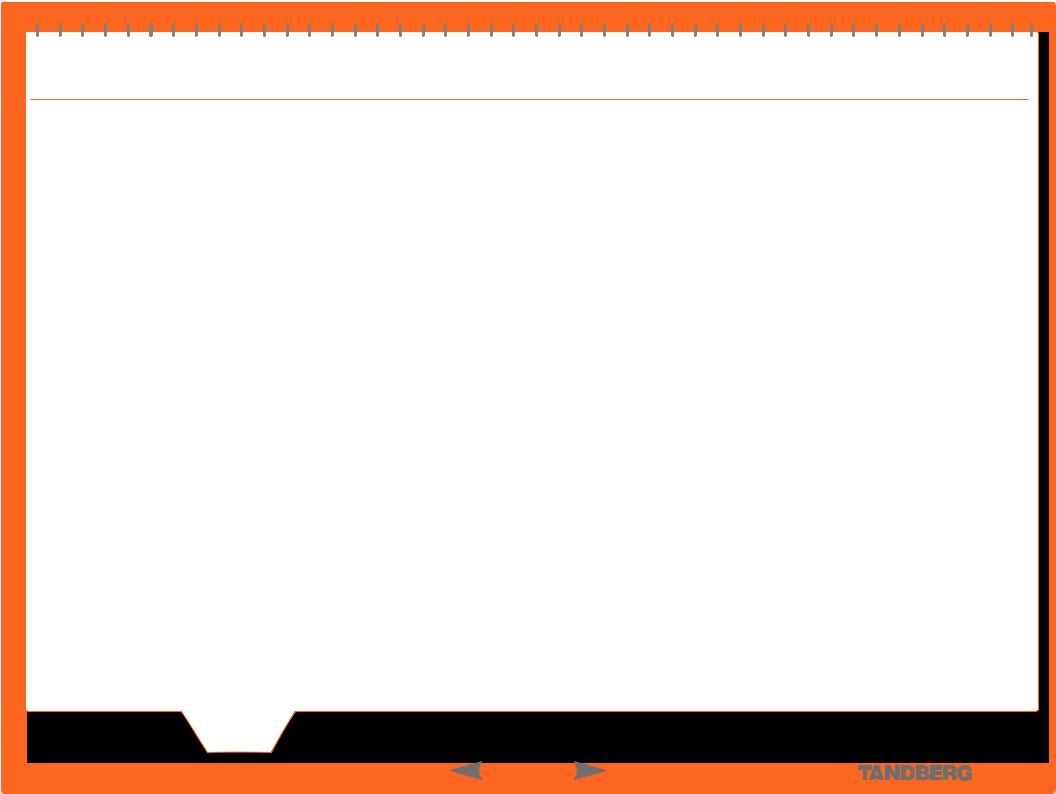
Introduction
Third Party Software, Licenses and Copyright (5:6)
TANDBERG MPS ADMINISTRATOR GUIDE
CONTRIBUTORS “AS IS” AND ANY EXPRESS OR IMPLIED WARRANTIES, INCLUDING, BUT NOT LIMITED TO, THE IMPLIED WARRANTIES OF MERCHANTABILITY AND FITNESS FOR A PARTICULAR PURPOSE ARE DISCLAIMED. IN NO EVENT SHALL THE REGENTS OR CONTRIBUTORS BE LIABLE FOR ANY DIRECT, INDIRECT, INCIDENTAL, SPECIAL, EXEMPLARY, OR CONSEQUENTIAL DAMAGES (INCLUDING, BUT NOT LIMITED TO, PROCUREMENT OF SUBSTITUTE GOODS OR SERVICES; LOSS OF USE, DATA, OR PROFITS; OR BUSINESS INTERRUPTION) HOWEVER CAUSED AND ON ANY THEORY OF LIABILITY, WHETHER IN CONTRACT, STRICT LIABILITY, OR TORT (INCLUDING NEGLIGENCE OR OTHERWISE) ARISING IN ANY WAY OUT OF THE USE OF THIS SOFTWARE, EVEN IF ADVISED OF THE POSSIBILITY OF SUCH DAMAGE.
LICENSE FOR lsof
Copyright 1994 Purdue Research Foundation, West Lafayette, Indiana 47907. All rights reserved.
Written by Victor A. Abell
This software is not subject to any license of the American Telephone and Telegraph Company or the Regents of the University of California.
Permission is granted to anyone to use this software for any purpose on any computer system, and to alter it and redistribute it freely, subject to the following restrictions:
1.Neither the authors nor Purdue University are responsible for any consequences of the use of this software.
2.The origin of this software must not be misrepresented, either by explicit claim or by omission. Credit to the authors and Purdue University must appear in documentation and sources.
3.Altered versions must be plainly marked as such, and must not be misrepresented as being the original software.
4.This notice may not be removed or altered.
LICENSE FOR net-snmp
Various copyrights apply to this package, listed in 4 separate parts below. Please make sure that you read all the parts. Up until 2001, the project was based at UC Davis, and the first part covers all code written during this time. From 2001 onwards, the project has been based at SourceForge, and Networks Associates Technology, Inc hold the copyright on behalf of the wider Net-SNMP community, covering all derivative work done since then. An additional copyright section has been added as Part 3 below also under a BSD license for the work contributed by Cambridge Broadband Ltd. to the project since 2001. An additional copyright section has been added as Part 4 below also under a BSD license for the work contributed by Sun Microsystems, Inc. to the project since 2003.
Code has been contributed to this project by many people over the years it has been in development, and a full list of contributors can be found in the README file under the THANKS section.
Part 1: CMU/UCD copyright notice: (BSD like)
Copyright 1989, 1991, 1992 by Carnegie Mellon University
Derivative Work - 1996, 1998-2000
Copyright 1996, 1998-2000 The Regents of the University of California.
All Rights Reserved
Permission to use, copy, modify and distribute this software and its documentation for any purpose and without fee is hereby granted, provided that the above copyright notice appears in all copies and that both that copyright notice and this permission notice appear in supporting documentation, and that the name of CMU and The Regents of the University of California not be used in advertising or publicity per-
taining to distribution of the software without specific written permission.
CMU AND THE REGENTS OF THE UNIVERSITY OF
CALIFORNIA DISCLAIM ALL WARRANTIES WITH REGARD TO THIS SOFTWARE, INCLUDING ALL IMPLIED WARRANTIES OF MERCHANTABILITY AND FITNESS. IN NO EVENT SHALL CMU OR THE REGENTS OF THE UNIVERSITY OF CALIFORNIA BE LIABLE FOR ANY SPECIAL, INDIRECT OR CONSEQUENTIAL DAMAGES OR ANY DAMAGES WHATSOEVER RESULTING FROM THE LOSS OF USE, DATA OR PROFITS, WHETHER IN AN ACTION OF CONTRACT, NEGLIGENCE OR OTHER TORTIOUS ACTION, ARISING OUT OF OR IN CONNECTION WITH THE USE OR PERFORMANCE OF THIS SOFTWARE.
Part 2: Networks Associates Technology, Inc copyright notice (BSD)
Copyright (c) 2001-2003, Networks Associates Technology, Inc
All rights reserved.
Redistribution and use in source and binary forms, with or without modification, are permitted provided that the following conditions are met:
•Redistributions of source code must retain the above copyright notice, this list of conditions and the following disclaimer.
•Redistributions in binary form must reproduce the above copyright notice, this list of conditions and the following disclaimer in the documentation and/or other materials provided with the distribution.
•Neither the name of the Networks Associates Technology, Inc nor the names of its contributors may be used to endorse or promoteproducts derived from this software without specific prior written permission.
THIS SOFTWARE IS PROVIDED BY THE COPYRIGHT HOLDERS AND CONTRIBUTORS “AS IS” AND ANY EXPRESS OR IMPLIED WARRANTIES, INCLUDING, BUT NOT LIMITED TO, THE IMPLIED WARRANTIES OF MERCHANTABILITY AND FITNESS FOR A PARTICULAR PURPOSE ARE DISCLAIMED. IN NO EVENT SHALL
THE COPYRIGHT HOLDERS OR CONTRIBUTORS BE LIABLE FOR ANY DIRECT, INDIRECT, INCIDENTAL, SPECIAL, EXEMPLARY, OR CONSEQUENTIAL DAMAGES (INCLUDING, BUT NOT LIMITED TO, PROCUREMENT OF SUBSTITUTE GOODS OR SERVICES; LOSS OF USE, DATA, OR PROFITS; OR BUSINESS INTERRUPTION) HOWEVER CAUSED AND ON ANY THEORY OF LIABILITY, WHETHER IN CONTRACT, STRICT LIABILITY, OR TORT (INCLUDING NEGLIGENCE OR OTHERWISE) ARISING IN ANY WAY OUT OF THE USE OF THIS SOFTWARE, EVEN IF ADVISED OF THE POSSIBILITY OF SUCH DAMAGE.
Part 3: Cambridge Broadband Ltd. copyright notice (BSD)
Portions of this code are copyright (c) 2001-2003, Cambridge Broadband Ltd.
All rights reserved.
Redistribution and use in source and binary forms, with or without modification, are permitted provided that the following conditions are met:
•Redistributions of source code must retain the above copyright notice, this list of conditions and the following disclaimer.
•Redistributions in binary form must reproduce the above copyright notice, this list of conditions and the following disclaimer in the documentation and/or other materials provided with the distribution.
•The name of Cambridge Broadband Ltd. may not be used to endorse or promote products derived from this software without specific prior written permission.
THIS SOFTWARE IS PROVIDED BY THE COPYRIGHT HOLDER “AS IS” AND ANY EXPRESS OR IMPLIED WARRANTIES, INCLUDING, BUT NOT LIMITED TO, THE IMPLIED WARRANTIES OF MERCHANTABILITY AND FITNESS FOR A PARTICULAR PURPOSE ARE DISCLAIMED. IN NO EVENT SHALL THE COPYRIGHT HOLDER BE LIABLE FOR ANY DIRECT, INDIRECT, INCI-
Main |
Introduction |
Installation |
Quick |
Using |
System |
System |
Gateway |
MCU |
Technical |
Appendices |
|
Setup |
the MPS |
Status |
Configuration |
Configuration |
Configuration |
Descriptions |
|||||
|
|
|
|
||||||||
D 13373.08 |
|
|
|
|
12 |
|
|
|
|
MPS |
|
NOVEMBER 2007 |
|
|
|
|
|
|
|
|
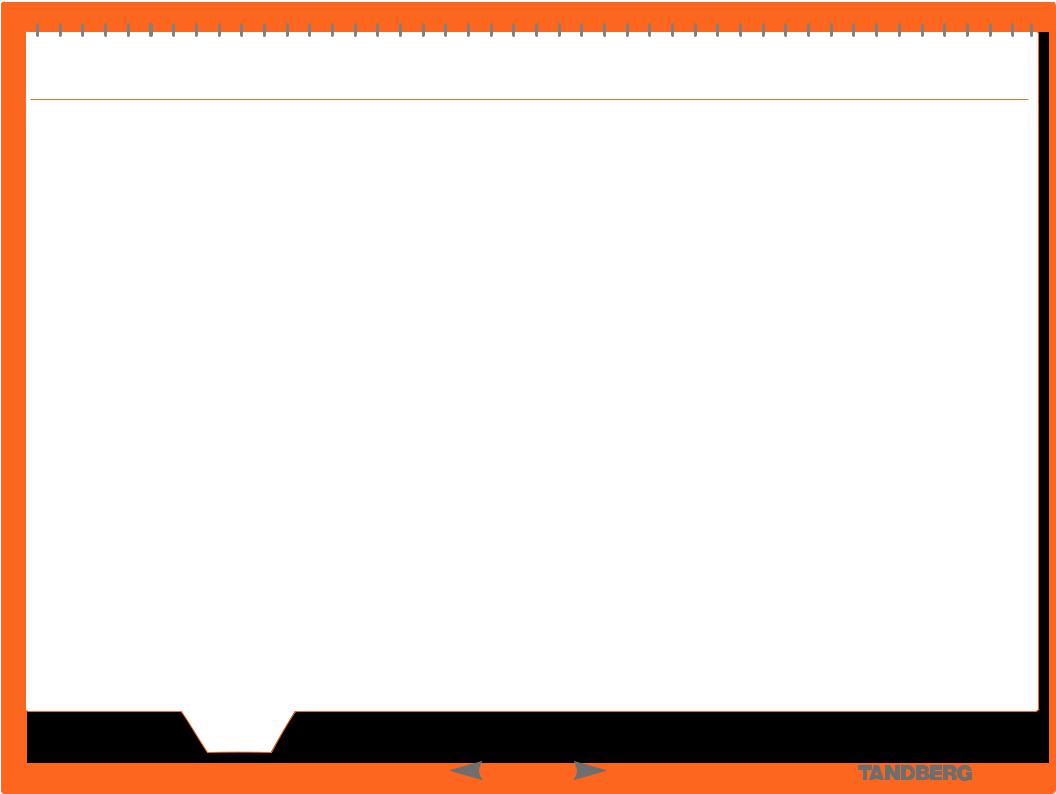
Introduction
Third Party Software, Licenses and Copyright (6:6)
TANDBERG MPS ADMINISTRATOR GUIDE
DENTAL, SPECIAL, EXEMPLARY, OR CONSEQUENTIAL DAMAGES (INCLUDING, BUT NOT LIMITED TO, PROCUREMENT OF SUBSTITUTE GOODS OR SERVICES; LOSS OF USE, DATA, OR PROFITS; OR BUSINESS INTERRUPTION) HOWEVER CAUSED AND ON ANY THEORY OF LIABILITY, WHETHER IN CONTRACT, STRICT LIABILITY, OR TORT (INCLUDING NEGLIGENCE OR OTHERWISE) ARISING IN ANY WAY OUT OF THE USE OF THIS SOFTWARE, EVEN IF ADVISED OF THE POSSIBILITY OF SUCH DAMAGE.
Part 4: Sun Microsystems, Inc. copyright notice (BSD)
Copyright © 2003 Sun Microsystems, Inc., 4150 Network Circle, Santa Clara, California 95054, U.S.A.
All rights reserved.
Use is subject to license terms below.
This distribution may include materials developed by third parties.
Sun, Sun Microsystems, the Sun logo and Solaris are trademarks or registered trademarks of Sun Microsystems, Inc. in the U.S. and other countries.
Redistribution and use in source and binary forms, with or without modification, are permitted provided that the following conditions are met:
•Redistributions of source code must retain the above copyright notice, this list of conditions and the following disclaimer.
•Redistributions in binary form must reproduce the above copyright notice, this list of conditions and the following disclaimer in the documentation and/or other materials provided with the distribution.
•Neither the name of the Sun Microsystems, Inc. nor the names of its contributors may be used to endorse or promote products derived from this software without specific prior written permission.
THIS SOFTWARE IS PROVIDED BY THE COPYRIGHT
HOLDERS AND CONTRIBUTORS “AS IS” AND ANY EXPRESS OR IMPLIED WARRANTIES, INCLUDING, BUT NOT LIMITED TO, THE IMPLIED WARRANTIES OF MERCHANTABILITY AND FITNESS FOR A PARTICULAR PURPOSE ARE DISCLAIMED. IN NO EVENT SHALL THE COPYRIGHT HOLDERS OR CONTRIBUTORS BE LIABLE FOR ANY DIRECT, INDIRECT, INCIDENTAL, SPECIAL, EXEMPLARY, OR CONSEQUENTIAL DAMAGES (INCLUDING, BUT NOT LIMITED TO, PROCUREMENT OF SUBSTITUTE GOODS OR SERVICES; LOSS OF USE, DATA, OR PROFITS; OR BUSINESS INTERRUPTION) HOWEVER CAUSED AND ON ANY THEORY OF LIABILITY, WHETHER IN CONTRACT, STRICT LIABILITY, OR TORT (INCLUDING NEGLIGENCE OR OTHERWISE) ARISING IN ANY WAY OUT OF THE USE OF THIS SOFTWARE, EVEN IF ADVISED OF THE POSSIBILITY OF SUCH DAMAGE.
Part 5: Sparta, Inc copyright notice (BSD)
Copyright (c) 2003, Sparta, Inc All rights reserved.
Redistribution and use in source and binary forms, with or without modification, are permitted provided that the following conditions are met:
•Redistributions of source code must retain the above copyright notice, this list of conditions and the following disclaimer.
•Redistributions in binary form must reproduce the above copyright notice, this list of conditions and the following disclaimer in the documentation and/or other materials provided with the distribution.
•Neither the name of the Networks Associates Technology, Inc nor the names of its contributors may be used to endorse or promote products derived from this software without specific prior written permission.
THIS SOFTWARE IS PROVIDED BY THE COPYRIGHT HOLDERS AND CONTRIBUTORS “AS IS” AND ANY EXPRESS OR IMPLIED WARRANTIES, INCLUDING,
BUT NOT LIMITED TO, THE IMPLIED WARRANTIES OF MERCHANTABILITY AND FITNESS FOR A PARTICULAR PURPOSE ARE DISCLAIMED. IN NO EVENT SHALL THE COPYRIGHT HOLDERS OR CONTRIBUTORS BE LIABLE FOR ANY DIRECT, INDIRECT, INCIDENTAL, SPECIAL, EXEMPLARY, OR CONSEQUENTIAL DAMAGES (INCLUDING, BUT NOT LIMITED TO, PROCUREMENT OF SUBSTITUTE GOODS OR SERVICES; LOSS OF USE, DATA, OR PROFITS; OR BUSINESS INTERRUPTION) HOWEVER CAUSED AND ON ANY THEORY OF LIABILITY, WHETHER IN CONTRACT, STRICT LIABILITY, OR TORT (INCLUDING NEGLIGENCE OR OTHERWISE) ARISING IN ANY WAY OUT OF THE USE OF THIS SOFTWARE, EVEN IF ADVISED OF THE POSSIBILITY OF SUCH DAMAGE.
LICENSE FOR popt
Copyright (c) 1998 Red Hat Software
Permission is hereby granted, free of charge, to any person obtaining a copy of this software and associated documentation files (the “Software”), to deal in the Software without restriction, including without limitation the rights to use, copy, modify, merge, publish, distribute, sublicense, and/or sell copies of the Software, and to permit persons to whom the Software is furnished to do so, subject to the following conditions:
The above copyright notice and this permission notice shall be included in all copies or substantial portions of the Software.
THE SOFTWARE IS PROVIDED “AS IS”, WITHOUT WARRANTY OF ANY KIND, EXPRESS OR IMPLIED, INCLUDING BUT NOT LIMITED TO THE WARRANTIES OF MERCHANTABILITY, FITNESS FOR A PARTICULAR PURPOSE AND NONINFRINGEMENT. IN NO EVENT SHALL THE X CONSORTIUM BE LIABLE FOR ANY CLAIM, DAMAGES OR OTHER LIABILITY, WHETHER IN AN ACTION OF CONTRACT, TORT OR OTHERWISE, ARISING FROM, OUT OF OR IN CONNECTION WITH THE SOFTWARE OR THE USE OR OTHER DEALINGS IN THE SOFTWARE.
Except as contained in this notice, the name of the X Consortium shall not be used in advertising or otherwise to promote the sale, use or other dealings in this Software without prior written authorization from the X Consortium.
LICENSE FOR zlib
zlib is (C) 1995-2002 Jean-loup Gailly and Mark Adler.
Main |
Introduction |
Installation |
Quick |
Using |
System |
System |
Gateway |
MCU |
Technical |
Appendices |
|
Setup |
the MPS |
Status |
Configuration |
Configuration |
Configuration |
Descriptions |
|||||
|
|
|
|
||||||||
D 13373.08 |
|
|
|
|
13 |
|
|
|
|
MPS |
|
NOVEMBER 2007 |
|
|
|
|
|
|
|
|
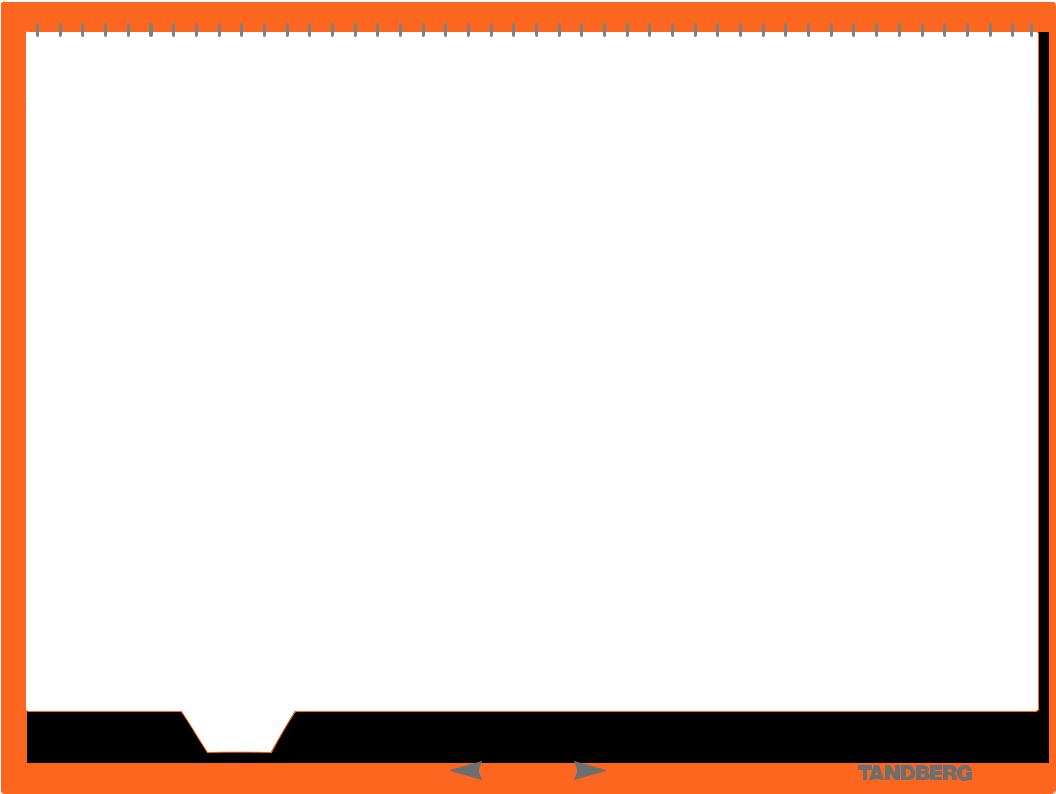
Introduction |
|
ADMINISTRATOR GUIDE |
|
Safety Instructions |
|
||
|
|
TANDBERG MPS |
|
|
|
|
|
For your protection please read these safety instructions |
dust. |
• If the apparatus has been exposed to rain or moisture |
|
completely before you connect the equipment to the power |
|
• If the apparatus has been subjected to excessive shock by |
|
source. Carefully observe all warnings, precautions and |
Vibration |
being dropped |
|
instructions both on the apparatus and in these operating |
|||
Do not operate the apparatus in areas with vibration or place it |
• If the cabinet has been damaged |
||
instructions. |
|||
• If the apparatus seems to be overheated |
|||
Retain this manual for future reference. |
on an unstable surface. |
||
|
• If the apparatus emits smoke or abnormal odor |
||
|
Power Connection and Hazardous Voltage |
||
Water and Moisture |
• If the apparatus fails to operate in accordance with the |
||
• Do not operate the apparatus under or near water – for |
• The product may have hazardous voltage inside. Never attempt |
operating instructions. |
|
to open this product, or any peripherals connected to the |
|
||
example near a bathtub, kitchen sink, or laundry tub, in a wet |
|
||
product, where this action requires a tool. |
Accessories |
||
basement, near a swimming pool or in other areas with high |
|||
• This product should always be powered from an earthed power |
|||
humidity. |
Use only accessories specified by the manufacturer, or sold with |
||
outlet. |
|||
• Never install jacks for communication cables in wet locations |
the apparatus. |
||
• Never connect attached power supply cord to other products. |
|||
unless the jack is specifically designed for wet locations. |
|
||
• Do not touch the product with wet hands. |
• In case any parts of the product has visual damage never |
Communication Lines |
|
|
attempt to connect mains power, or any other power source, |
• Never touch uninstalled communication wires or terminals un- |
|
|
before consulting service personnel |
||
Cleaning |
less the telephone line has been disconnected at the network |
||
• The plug connecting the power cord to the product/power sup- |
|||
• Unplug the apparatus from communication lines, mains power- |
interface. |
||
outlet or any power source before cleaning or polishing. |
ply serves as the main disconnect device for this equipment. |
• Do not use communication equipment to report a gas leak in |
|
The power cord must always be easily accessible. |
|||
• Do not use liquid cleaners or aerosol cleaners. |
the vicinity of the leak. |
||
• Route the power cord so as to avoid it being walked on or |
|||
• To reduce the risk of fire, use only No. 26 AWG or larger tele- |
|||
• Use a lint-free cloth lightly moistened with water for cleaning |
pinched by items placed upon or against it. Pay particular at- |
||
communication line cord (ISDN cables). |
|||
the exterior of the apparatus. |
tention to the plugs, receptacles and the point where the cord |
||
|
|||
|
exits from the apparatus. |
|
Ventilation
•Do not block any of the ventilation openings of the apparatus.
•Never cover the slots and openings with a cloth or other material.
•Never install the apparatus near heat sources such as radiators, heat registers, stoves, or other apparatus (including amplifiers) that produce heat.
•Do not place the product in direct sunlight or close to a surface directly heated by the sun.
Lightning
Never use this apparatus, or connect/disconnect communication cables or power cables during lightning storms.
Dust
Do not operate the apparatus in areas with high concentration of
•Do not tug the power cord
•If the provided plug does not fit into your outlet, consult an electrician.
•Never install cables, or any peripherals, without first unplugging the device from it’s power source.
Servicing
Do not attempt to service the apparatus yourself as opening or removing covers may expose you to dangerous voltages or other hazards, and will void the warranty. Refer all servicing to qualified service personnel.
Unplug the apparatus from its power source and refer servicing to qualified personnel under the following conditions:
•If the power cord or plug is damaged or frayed
•If liquid has been spilled into the apparatus
•If objects have fallen into the apparatus
Product Approvals
Information about product approvals and CE declarations are found in the Product Approvals in the Appendices section.
Main |
Introduction |
Installation |
Quick |
Using |
System |
System |
Gateway |
MCU |
Technical |
Appendices |
|
Setup |
the MPS |
Status |
Configuration |
Configuration |
Configuration |
Descriptions |
|||||
|
|
|
|
||||||||
D 13373.08 |
|
|
|
|
14 |
|
|
|
|
MPS |
|
NOVEMBER 2007 |
|
|
|
|
|
|
|
|
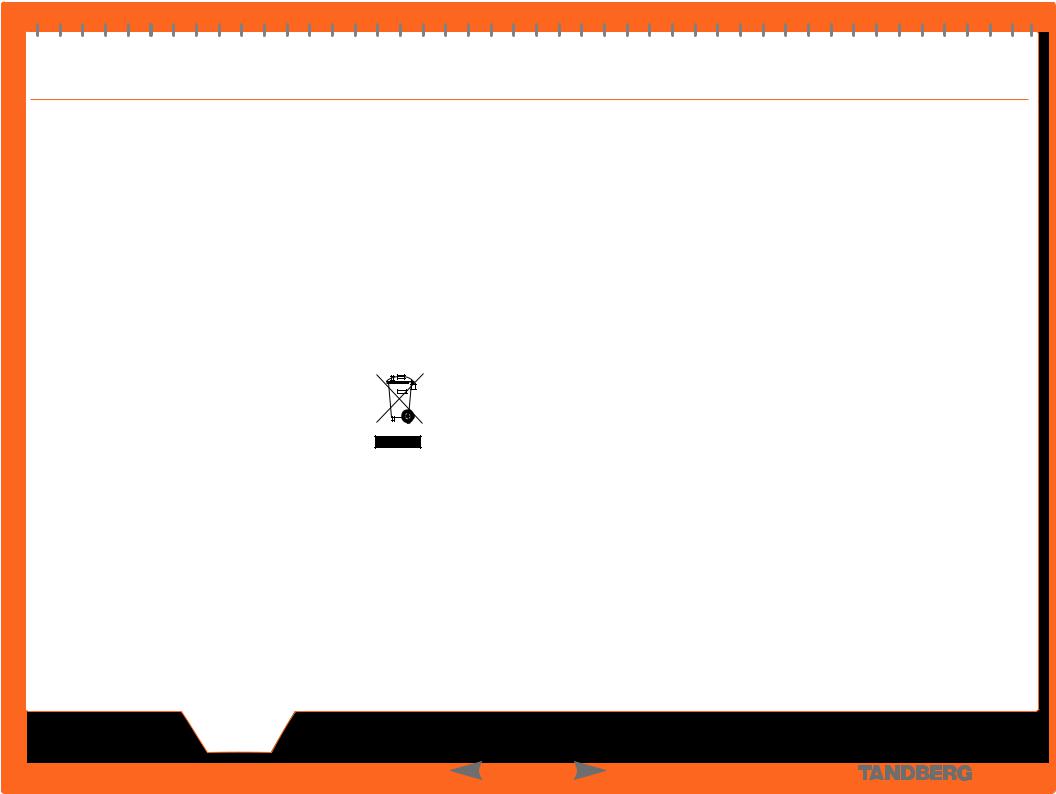
Introduction
Environmental Issues
TANDBERG MPS ADMINISTRATOR GUIDE
Thank you for buying a product which contributes to a reduction in pollution, and thereby helps save the environment. Our products reduce the need for travel and transport and thereby reduce pollution. Our products have either none or few consumable parts (chemicals, toner, gas, paper). Our products are low energy consuming products.
TANDBERG’s Environmental Policy
Environmental stewardship is important to TANDBERG’s culture. As a global company with strong corporate values, TANDBERG is committed to following international environmental legislation and designing technologies that help companies, individuals and communities creatively address environmental challenges.
TANDBERG’s environmental objectives are to:
•Develop products that reduce energy consumption, CO2 emissions, and traffic congestion
•Provide products and services that improve quality of life for our customers
•Produce products that can be recycled or disposed of safely at the end of product life
•Comply with all relevant environmental legislation.
European Environmental Directives
As a manufacturer of electrical and electronic equipment TANDBERG is responsible for compliance with the requirements in the European Directives 2002/96/EC (WEEE) and 2002/95/EC (RoHS).
The primary aim of the WEEE Directive and RoHS Directive is to reduce the impact of disposal of electrical and electronic equipment at end-of-life. The WEEE Directive aims to reduce the amount of WEEE sent for disposal to landfill or incineration by requiring producers to arrange for collection and recycling. The RoHS Directive bans the use of certain heavy metals and
brominated flame retardants to reduce the environmental impact of WEEE which is landfilled or incinerated.
TANDBERG has implemented necessary process changes to comply with the European RoHS Directive (2002/95/EC) and the European WEEE Directive (2002/96/EC).
Waste Handling
In order to avoid the dissemination of hazardous substances in our environment and to diminish the
pressure on natural resources, we encourage you to use the appropriate take-back systems in your area.
Those systems will reuse or recycle most of the materials of your end of life equipment in a sound
way.
TANDBERG products put on the market after August 2005 are marked with a crossed-out wheelie bin symbol that invites you to use those take-back systems.
Please contact your local supplier, the regional waste administration or http://www.tandberg.com/recycling if you need more information on the collection and recycling system in your area.
Information for Recyclers
As part of compliance with the European WEEE Directive, TANDBERG provides recycling information on request for all types of new equipment put on the market in Europe after August 13th 2005.
Please contact TANDBERG and provide the following details for the product for which you would like to receive recycling information:
•Model number of TANDBERG product
•Your company’s name
•Contact name
•Address
•Telephone number
•E-mail.
Digital User Guides
TANDBERG is pleased to announce that we have replaced the printed versions of our user guides with a digital CD version. Instead of a range of different user guides, there is now one CD
– which can be used with all TANDBERG products – in a variety of languages. The environmental benefits of this are significant. The CDs are recyclable and the savings on paper are huge. A simple web-based search feature helps you directly access the information you need. In addition, the TANDBERG video systems now have an intuitive on-screen help function, which provides a range of useful features and tips. The contents of the CD can still be printed locally, whenever needed.
Main |
Introduction |
Installation |
Quick |
Using |
System |
System |
Gateway |
MCU |
Technical |
Appendices |
|
Setup |
the MPS |
Status |
Configuration |
Configuration |
Configuration |
Descriptions |
|||||
|
|
|
|
||||||||
D 13373.08 |
|
|
|
|
15 |
|
|
|
|
MPS |
|
NOVEMBER 2007 |
|
|
|
|
|
|
|
|
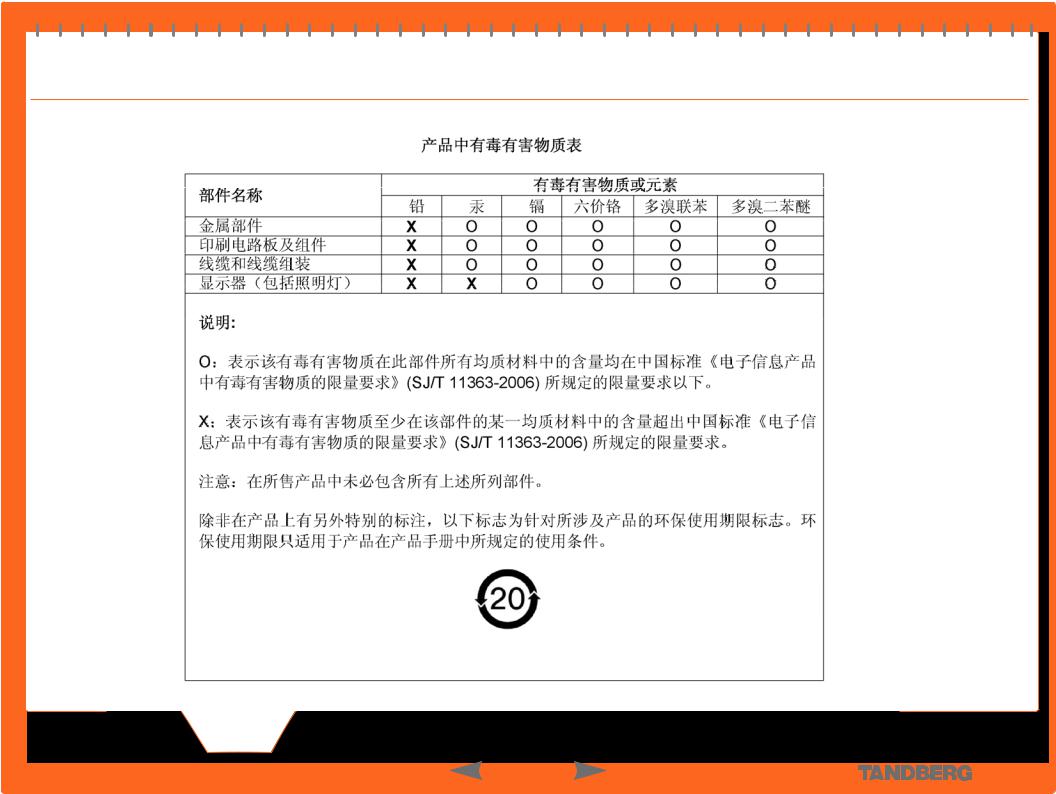
Introduction
Environmental Issues - RoHS Table
TANDBERG MPS ADMINISTRATOR GUIDE
China RoHS Table
Main |
Introduction |
Installation |
Quick |
Using |
System |
System |
Gateway |
MCU |
Technical |
Appendices |
|
Setup |
the MPS |
Status |
Configuration |
Configuration |
Configuration |
Descriptions |
|||||
|
|
|
|
||||||||
D 13373.08 |
|
|
|
|
16 |
|
|
|
|
MPS |
|
NOVEMBER 2007 |
|
|
|
|
|
|
|
|
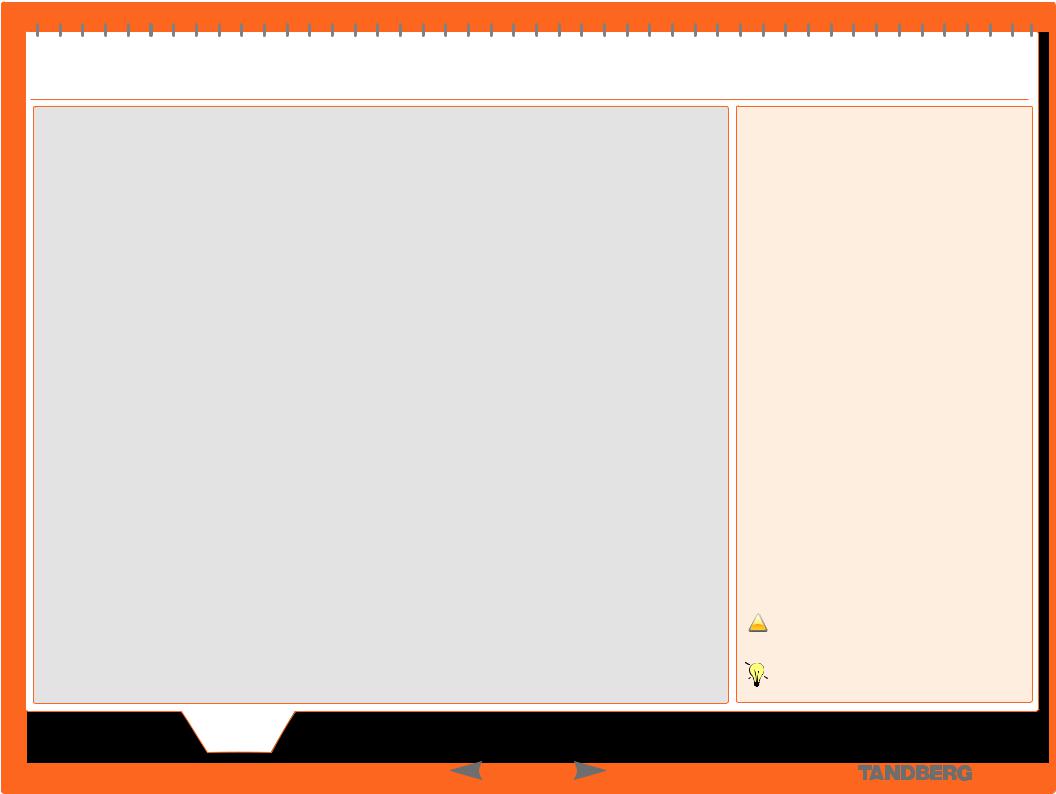
Introduction
Features Overview & MPS Capacity
TANDBERG MPS ADMINISTRATOR GUIDE
This Administrator Guide is provided to help you make the best use of your TANDBERG MPS, Media Processing System.
The TANDBERG MPS enables sites on IP (H.323 and SIP), ISDN and High Speed Serial (V.35/RS449/RS530 w/RS366 support)
to participate in meetings with each other, and at the same time it offers superior quality and ease of use in one fully-featured multipoint control unit, MCU.
The TANDBERG MPS may also include the optional Gateway functionality.
MPS Models
The TANDBERG MPS can be found in two models, the MPS 800 a 9U-sized unit, and the MPS 200 a 3U-sized unit.
The two models differ in the size of the chassis and the number of boards that they can host. However there are no differences in the feature set. Therefore in this manual, we will use the term TANDBERG MPS to refer to both models, unless a specific situation requires referring to each model with its own name.
Main Features
•IP, ISDN PRI, Leased E1/T1 (G.703) and High Speed Serial (V.35/RS449/RS530 w/RS366 support) networks are supported at call rates of up to 2 Mbps for each call.
•Up to 40 simultaneous conferences with the MPS 800, and up to 10 simultaneous conferences with the MPS 200.
•Up to 160 video sites and 48 telephony calls with the MPS 800 and up to 40 video sites and 32 telephony calls with the MPS 200 can be supported at the same time in some configurations, each benefiting from the same superb audio and video quality. The TANDBERG MPS can also be
used purely as an audio-bridge.
•Secure ConferenceTF - using standard based AES 128 and DES encryption. Support both H.235 v2 and v3 in the same conference.
•Best ImpressionTF - Automatic selection of layout and resolution depending on number of meeting participants.
•Numerous different conference layouts, 16:9 wide formats and Voice Switched mode.
•Dual Video Stream - support for DuoVideoTF, H.239 and BFCP.
•DuoVideoTF/H.239/BFCP - automatically distributed to conference participants supporting these protocols. Support for mix of DuoVideoTF and the H.239 or BFCP protocols in same conference. Endpoints not supporting these protocols will receive main stream.
•DownspeedingTF - if channels are dropped during a videoconferencing session, the connection is automatically re-established without interruption.
•Audio and video transcoding to the best quality available.
•Secure Access - support SSH, XML/SOAP over HTTPS, Web (HTTP) encrypted password. The Telnet, SSH, HTTP, HTTPS and SNMP services can be disabled.
•Web-interface for system management, call management, diagnostics, multi language and software uploads.
•Worldwide compatibility with standardsbased videoconferencing systems.
•Gateway functionality – Embedded gate-
way with up to 80 Gateway calls on the MPS 800 and up to 20 Gateway calls on the MPS 200.
•Ad Hoc functionality and Single number dial in, with waiting room and dynamic access and authorization mechanisms. Possibility to pre-configure up to 500 personal conference and service prefix for dynamic allocation of personal conference.
•Up to double bandwidth capacity on IP only, non encrypted calls.
•Support for participant identification in video, with localizations support (Chinese, Traditional Chinese, Thai, Japanese, Korean and Russian).
•Encoding support for High Definition Continous Precence resolution.
•Optimal Voice Switch - Video switching, providing point-to-point quality.
Options
Simplifies scheduling and the use of video meeting resources through highly automated functionality:
•Management using TANDBERG Management Suite.
•Scheduling using TANDBERG Scheduler, Microsoft® Outlook®, Microsoft® Office Communicator® or IBM Lotus Notes®
•Ad Hoc conferencing through Microsoft® Office Communicator®
TANDBERG MPS Capacity
The TANDBERG MPS 800 can support up to
•40 simultaneous conferences
•160 simultaneous video calls
•48 simultaneous telephone calls
•80 simultaneous Gateway calls
The TANDBERG MPS 200 can support up to
•10 simultaneous conferences
•40 simultaneous video calls
•32 simultaneous telephone calls
•20 simultaneous Gateway calls
TANDBERG MPS Capacity on IP
The maximum bandwidth on IP for each Media Processing Board is 15360 kbps. With 8 Media Processing Boards installed in a MPS 800 the maximum bandwidth on IP is 122800 kbps.
Setting Encryption to On will decrease the maximum bandwidth throughput, but not the total number of ports. The maximum bandwidth for each of the Media Processing Boards is 7680 kbps with Encryption set to On in all calls.
TANDBERG MPS Capacity on ISDN
The maximum bandwidth for ISDN for each Media Processing Board is 7680 kbps. With 4 E1/T1 ISDN Interface Card installed in a MPS 800, and 8 Media Processing Boards the maximum bandwidth is 61440 kbps.
One V.35 Serial Interface Card could handle maximum 61440 kbps in maximum 32 calls. More V.35 Serial Interface Card would increase, not the bandwidth capacity, but the number of possible calls up to a maximum of 128 calls. The Gateway capacity is 7680 kbps per Media.
In a secure conference, there is no support for tele-
!phone participants.


 To increase the capacity, the MCU can be connected
To increase the capacity, the MCU can be connected

 in a cascade. See Technical Descriptions > Distrib-
in a cascade. See Technical Descriptions > Distrib-  uted MCUs for details.
uted MCUs for details.
Main |
Introduction |
Installation |
Quick |
Using |
System |
System |
Gateway |
MCU |
Technical |
Appendices |
|
Setup |
the MPS |
Status |
Configuration |
Configuration |
Configuration |
Descriptions |
|||||
|
|
|
|
||||||||
D 13373.08 |
|
|
|
|
17 |
|
|
|
|
MPS |
|
NOVEMBER 2007 |
|
|
|
|
|
|
|
|
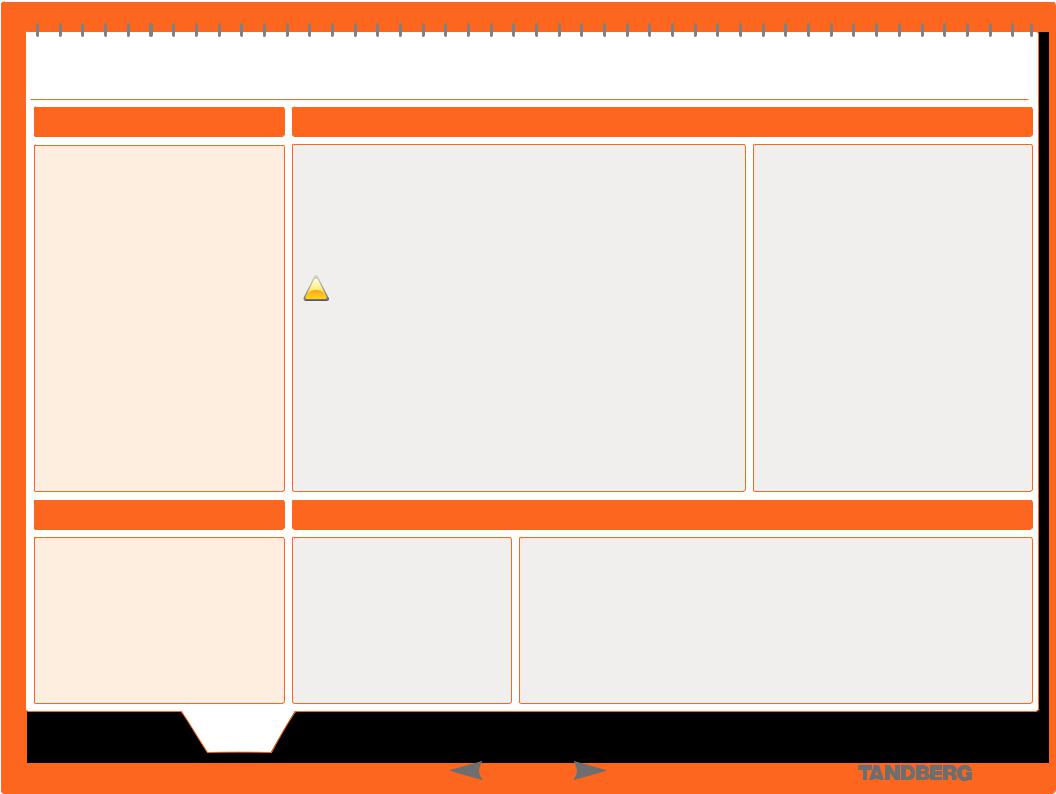
Introduction
TANDBERG MPS at a Glance
TANDBERG MPS ADMINISTRATOR GUIDE
Rack Mountable Chassis |
Front View |
The TANDBERG MPS chassis is 19” rack-mount- able.
•On the front of the chassis is a Liquid Crystal Display (LCD) for initial configuration and basic system information.
•There are four Light Emitting Diodes (LEDs) indicating the power status.
•The backplane of the chassis is provided with advanced CompactPCI technology for high speed communication between the boards.
•There are three cooling fans in the lower front of the chassis.
•The TANDBERG MPS 800 has a 9U-19” rack-mountable chassis that can host up to 8 Media Processing Boards and up to 4 Network Interface Cards.
•The TANDBERG MPS 200 has 3U-19” rackmountable chassis that can host up to 2 Media Processing Boards and up to 2 Network Interface Cards.
System Controller Board
The System Controller Board is installed in the first slot in the chassis.
•In the MPS 800 the first slot is the first from the left of the chassis.
•In the MPS 200 the first slot is the first from the bottom of the chassis.
It is very important that the System ! Controller Board is installed in the first slot in the chassis! Installing in any other slot can damage the System Con-
troller Board.
The System Controller Board takes care of the following functions:
•Call control
•System management
•The embedded Web server
The System Controller Board is equipped with the following interfaces:
•1 X LAN / Ethernet (RJ-45) 10/100 Mbit on the front.
•2 X LAN / Ethernet (RJ-45) 10/100 Mbit on the back (only 1 in use, Enet2)
•1 x COM port on the front
•2 X USB port (these are for future use)
The LAN interface on the System Controller Board is for management/call control signalling. Note that management is disabled on Enet2. This interface is only for call control. The 2 LAN interfaces will allow you to connect to two non-overlapping IP-networks so that participants with no IP-routing between them can be joined in the same conference. At least one Media Processing Board must be connected to each network. The 2xLAN interfaces will give the TANDBERG MPS support for two Gatekeepers, one on each network. To use the COM1 port you need a RJ-45 to RS-232 converter. See the Technical Description section for further details of the COM port pin out on the System Controller Board.
Media Processing Board
Add-on boards for media processing are installed in adjacent slots in the chassis. The Media Processing Boards handles the following functions:
•Video processing. See Video Features in the Technical Descriptions section for details.
•Audio processing. See Audio > Create Conference in the Using the MPS section for details.
•Transcoding. See Transcoding and Ratematching in the Technical Descriptions section for details.
•Encryption. See Secure Conference (Encryption) in the Technical Descriptions section for details.
•Continuous Presence/Voice Switching. See Video Features in the Technical Descriptions section for details.
Each of the Media Processing Boards is equipped with 1xLAN interface for H.323 and SIP media. You will also find 4 Light Emitting Diodes (LEDs) for board status. With the TANDBERG MPS 800, there is support for up to 8 Media Processing Boards. With the TANDBERG MPS 200, there is support for up to 2 Media Processing Boards. See the Technical Description section for further details on the Media Processing Board.
Rear View
The TANDBERG MPS 800 is shipped with 2 hot-swappable power units for configurations of 1 to 3 Media Processing Boards. If the unit has more than 3 Media Processing Boards the TANDBERG MPS 800 has to be equipped with 3 hot-swappable power units. The power units are installed at the back of the chassis. You will also find the power switch/connector at the back of the chassis.
The TANDBERG MPS 200 is always shipped with 1 power unit integrated in the chassis.
Main |
Introduction |
D 13373.08
NOVEMBER 2007
System Controller Board - Rear View
The second LAN interface of the System Controller Board is accessible from the rear side.
See the Technical Description section for further details on the System Controller Board.
Network Interface Cards
The Network Interface Cards of the TANDBERG MPS are installed from the rear panel.
There are two types of Network Interface Cards:
•PRI E1/T1 ISDN Interface Card (IIC-8).
Each PRI E1/T1 ISDN Interface Card has 8 x PRI interfaces.
•V.35 Serial Interface Card (SIC-32).
Each of the V.35 Serial Interface Card has 32 x V.35/RS366 ports.
There is support for up to 4 Network Interface Cards.
There can be a mix of PRI E1/T1 ISDN Interface Cards and V.35 Serial Interface Cards.
The PRI E1/T1 ISDN Interface Card and the V.35 Serial Interface Card may only be installed in slot 1-6. (1 being the first Media Processing Board, left from the System Controller Card, seen from the rear).
See the Technical Description section for further details of the different Network Interface Cards.
Installation |
Quick |
Using |
System |
System |
Gateway |
MCU |
Technical |
Appendices |
|
Setup |
the MPS |
Status |
Configuration |
Configuration |
Configuration |
Descriptions |
|||
|
|
||||||||
|
|
18 |
|
|
|
|
|
MPS |
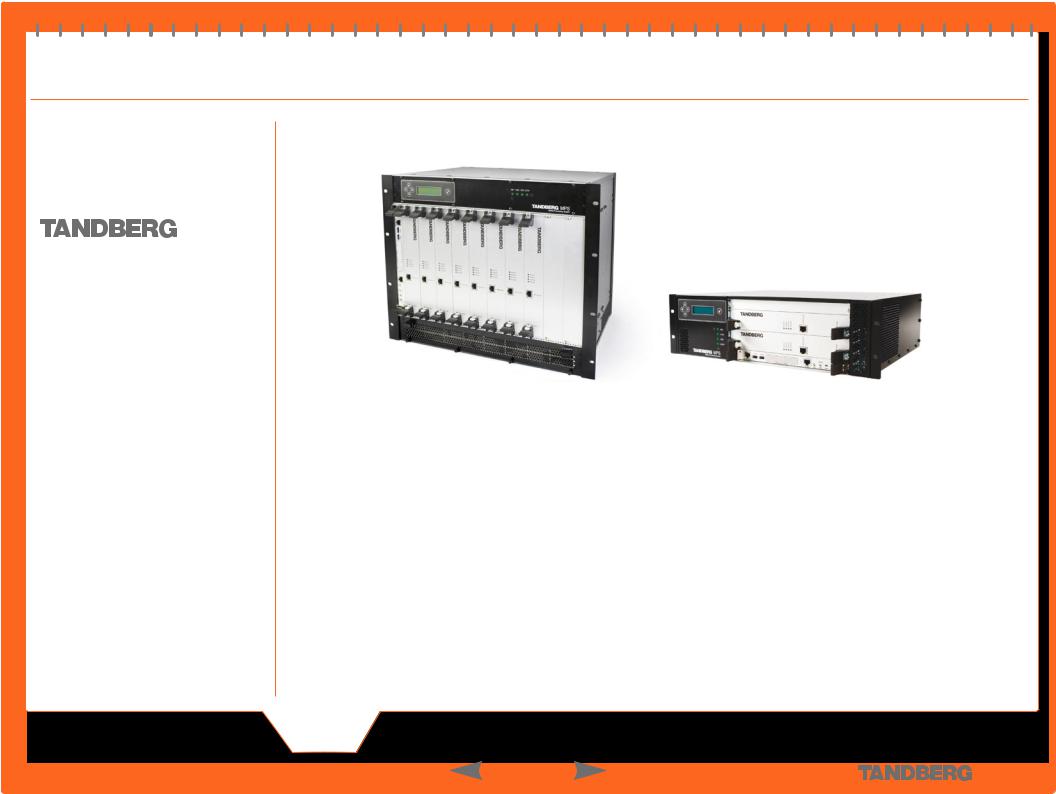
TANDBERG MPS ADMINISTRATOR GUIDE
MPS 200 MPS 800
We recommend that you check the TANDBERG web site regularly for updated versions of this manual:
http://www.tandberg.com/support/ documentation.php
Installation
This section describes the first time installation of the MPS - Media Processing System. The section covers unpacking, what’s in the box, mounting the MPS, cable connections, starting up the system and initial IP configuration using LCD.
You will also find pictures of the MPS 800 and MPS 200 with a description of the interfaces.
Main |
Introduction |
Installation |
Quick |
Using |
System |
System |
Gateway |
MCU |
Technical |
Appendices |
|
Setup |
the MPS |
Status |
Configuration |
Configuration |
Configuration |
Descriptions |
|||||
|
|
|
|
||||||||
D 13373.08 |
|
|
|
|
19 |
|
|
|
|
MPS |
|
NOVEMBER 2007 |
|
|
|
|
|
|
|
|
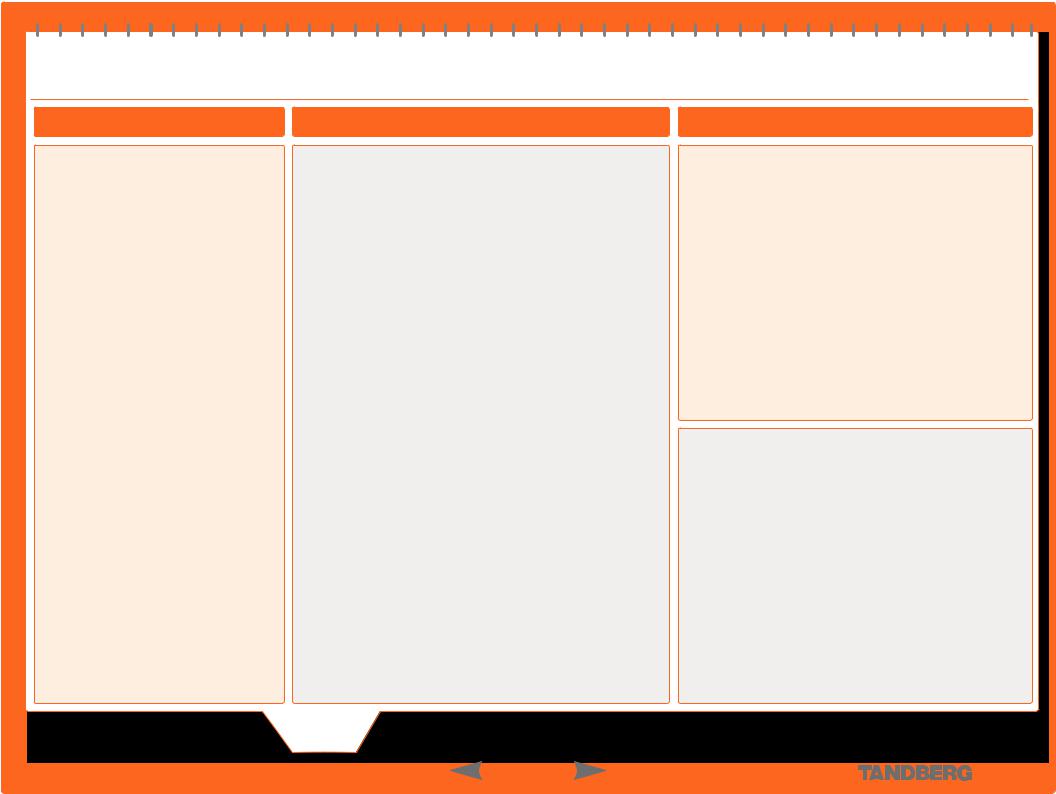
Installation
Precautions, Unpacking and Mounting
TANDBERG MPS ADMINISTRATOR GUIDE
Precautions
Please read carefully:
•Never install communication equipment during a lightning storm.
•Never install jacks for communication cables in wet locations unless the jack is specifically designed for wet locations.
•Never touch uninstalled communication wires or terminals unless the communication line has been disconnected at the network interface.
•Use caution when installing or modifying communication lines.
•Avoid using communication equipment (other than a cordless type) during an electrical storm. There may be a remote risk of electrical shock from lightning.
•Do not use communication equipment to report a gas leak in the vicinity of the leak.
•The socket outlet shall be installed near the equipment and shall be easily accessible.
•Never install cables without first switching the power OFF.
•This product complies with directives: LVD 73/23/EC and EMC 89/366/EEC.
•Caution - Double pole fusing.
•Power must be switched off before power supplies can be removed from or installed into the unit.
What is in the Box?
Unpacking
To avoid damage to the unit during transportation, the TANDBERG MPS is delivered in a special shipping box.
The shipping box contains the following components:
1.Chassis:
a.MPS 200, a 3U chassis with power supply.
b.or MPS 800, a 9U chassis with 2 or 3 x Power Units (depending on the number of Media Processing Boards installed)
c.1 x System Controller Board
d.The Media Processing Boards ordered
e.PRI E1/T1 ISDN Interface Card (if ordered)
f.V.35 Serial Interface Card (if ordered)
2.Administrator Guide and other documentation on CD
3.Installation sheets
4.4 screws and 4 nuts for rack mounting and 4 pads
5.Cables:
a.Power cable
b.Ethernet cables
c.ISDN cables (optional)
d.V.35 kit (optional). The kit includes cables that convert from highdensity connectors on V.35 card to TANDBERG’s standard V.35 connectors (26pin DSUB) and 19” rack-mountable panel where the V.35 connectors will fit.
e.RJ45 to RS-232 converter cable
Rack Mounting
Preparations on Site
The mounting space must be prepared before you start:
•Make sure the TANDBERG MPS is accessible and that all cables can be easily connected
•For ventilation: Leave a space of at least 10cm (4 inches) behind the TANDBERG MPS’s rear panel and 10cm (4 inches) in front of the front panel
•The room in which you install the TANDBERG MPS should have an ambient temperature between 0ºC and 35ºC (32ºF and 95ºF) and between 10% and 90% non-condensing relative humidity
•Do not place heavy objects directly on top of the TANDBERG MPS
•Do not place hot objects directly on top, or directly beneath the TANDBERG MPS
•Use a grounded AC power outlet for the TANDBERG MPS.
Mounting the MPS on a Rack
The TANDBERG MPS comes with 4 screws and 4 nuts for mounting in standard 19” racks. The chassis is equipped with brackets.
1.Before starting the rack mounting, please make sure the TANDBERG MPS is placed securely on a hard, flat surface.
2.Disconnect the AC power cable.
3.Make sure that the mounting space is according to the Preparations on Site in the section above.
4.Insert the chassis into a 19” rack, and secure with screws in the front (four screws) and nuts (four nuts).
Main |
Introduction |
Installation |
Quick |
Using |
System |
System |
Gateway |
MCU |
Technical |
Appendices |
|
Setup |
the MPS |
Status |
Configuration |
Configuration |
Configuration |
Descriptions |
|||||
|
|
|
|
||||||||
D 13373.08 |
|
|
|
|
20 |
|
|
|
|
MPS |
|
NOVEMBER 2007 |
|
|
|
|
|
|
|
|
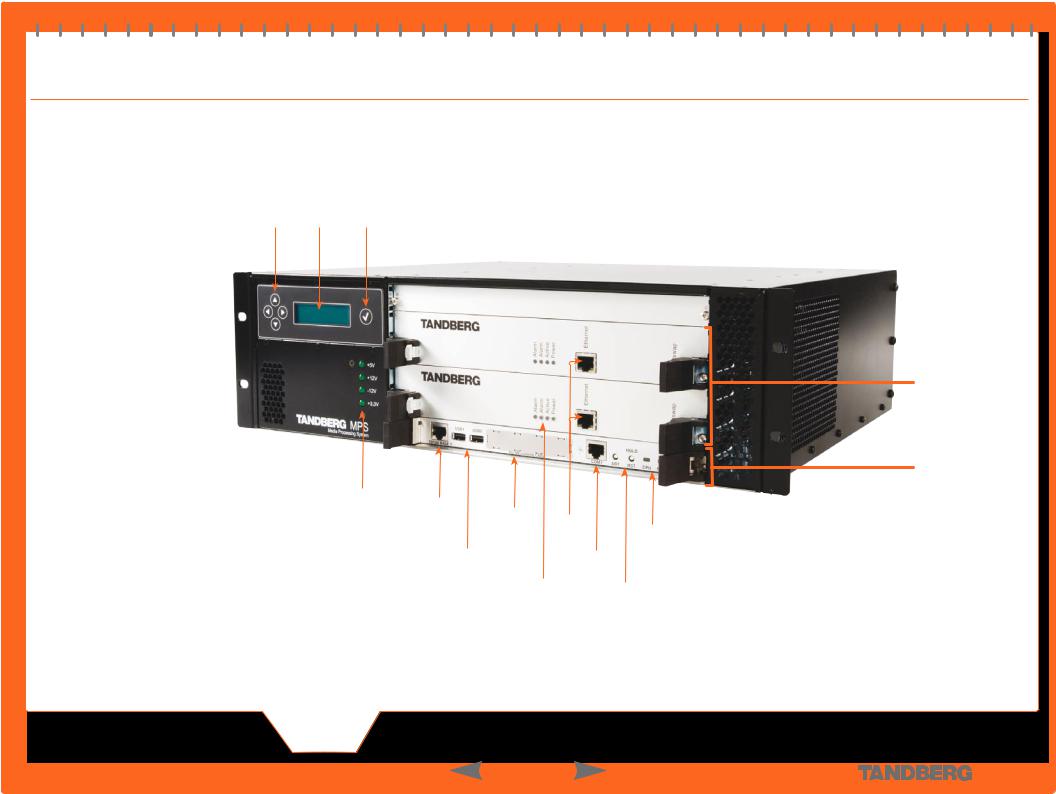
Installation
MPS 200 with 2 Media Processing Boards - Front Side
TANDBERG MPS ADMINISTRATOR GUIDE
Use Arrow keys to |
|
navigate in the menu |
Display Enter/OK key |
Brackets for 
Rack Mounting
Screw holes for 
Rack Mounting
LEDs for
power status 10/100 BASE T
Media Processing
Boards
System Controller
Board (in slot 1)
PCI MezzaEthernet
nine Card |
LEDs for CPU |
|
and FAILURE |
USB 0 |
COM1 |
USB 1 |
|
LEDs |
RESET |
for the |
button |
media |
|
board |
|
Main |
Introduction |
Installation |
Quick |
Using |
System |
System |
Gateway |
MCU |
Technical |
Appendices |
|
Setup |
the MPS |
Status |
Configuration |
Configuration |
Configuration |
Descriptions |
|||||
|
|
|
|
||||||||
D 13373.08 |
|
|
|
|
21 |
|
|
|
|
MPS |
|
NOVEMBER 2007 |
|
|
|
|
|
|
|
|
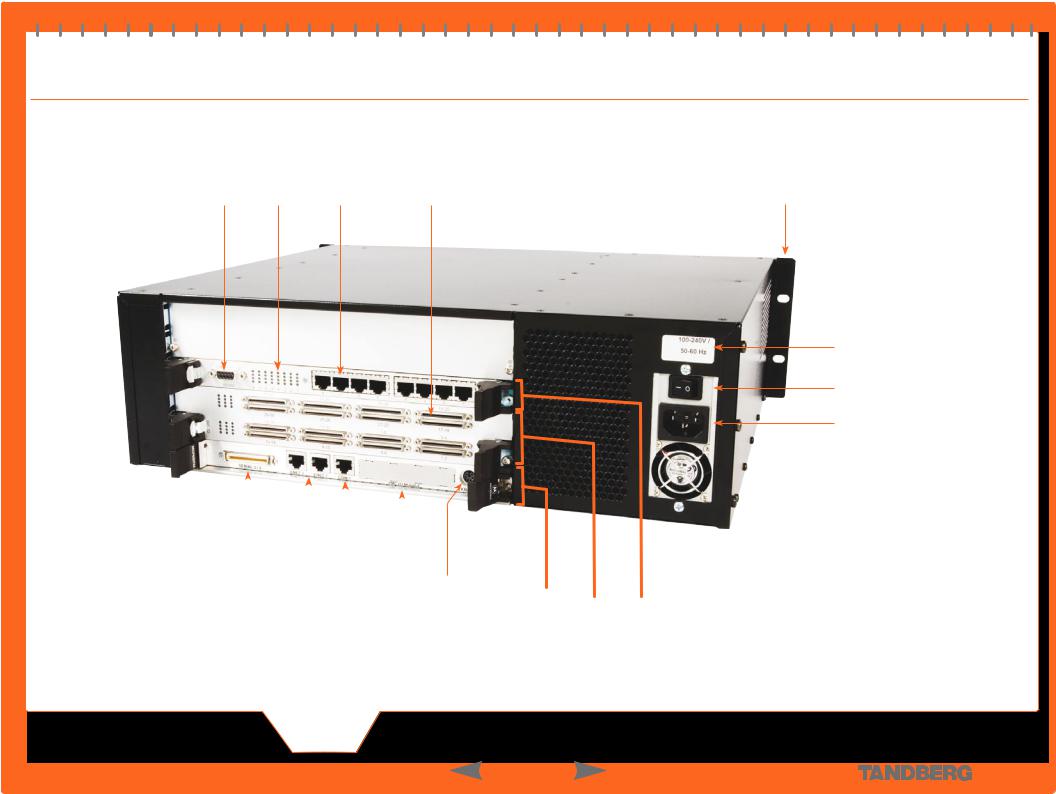
Installation
MPS 200 with ISDN and V.35 Network Cards - Rear Side
TANDBERG MPS ADMINISTRATOR GUIDE
LEDs for |
|
V.35 |
Bracket for Rack |
E1/T1 |
E1/T1 |
||
RS232 Line 1-8 |
Lines 1-8 |
Lines 1-32 |
Mounting (in front) |
Voltage / Frequency
Information
Power Switch On/Off
AC Power Inlet
|
|
|
|
|
|
|
|
|
|
|
|
|
|
|
|
|
|
|
|
|
|
|
|
|
|
|
|
|
|
|
|
|
Serial 3/4 |
ENET 1 |
COM1 |
|
|
|
|
|
|||
|
|
PMC I/O |
|
|
|
|||||
|
|
ENET 2 |
KB/MS |
|
|
|||||
|
|
|
|
|
|
|||||
|
|
|
|
Module |
|
|
||||
|
|
|
|
|
|
System |
|
|
||
|
|
|
|
|
|
|
|
|
|
|
|
|
|
|
|
|
|
|
Controller V.35 |
PRI E1/ |
|
|
|
|
|
|
|
|
|
Board |
Serial |
T1 ISDN |
|
|
|
|
|
|
|
|
Interface |
Network |
|
|
|
|
|
|
|
|
|
(slot 1) |
||
|
|
|
|
|
|
|
|
Card |
Interface |
|
|
|
|
|
|
|
|
|
|
||
Card
Main |
Introduction |
Installation |
Quick |
Using |
System |
System |
Gateway |
MCU |
Technical |
Appendices |
|
Setup |
the MPS |
Status |
Configuration |
Configuration |
Configuration |
Descriptions |
|||||
|
|
|
|
||||||||
D 13373.08 |
|
|
|
|
22 |
|
|
|
|
MPS |
|
NOVEMBER 2007 |
|
|
|
|
|
|
|
|
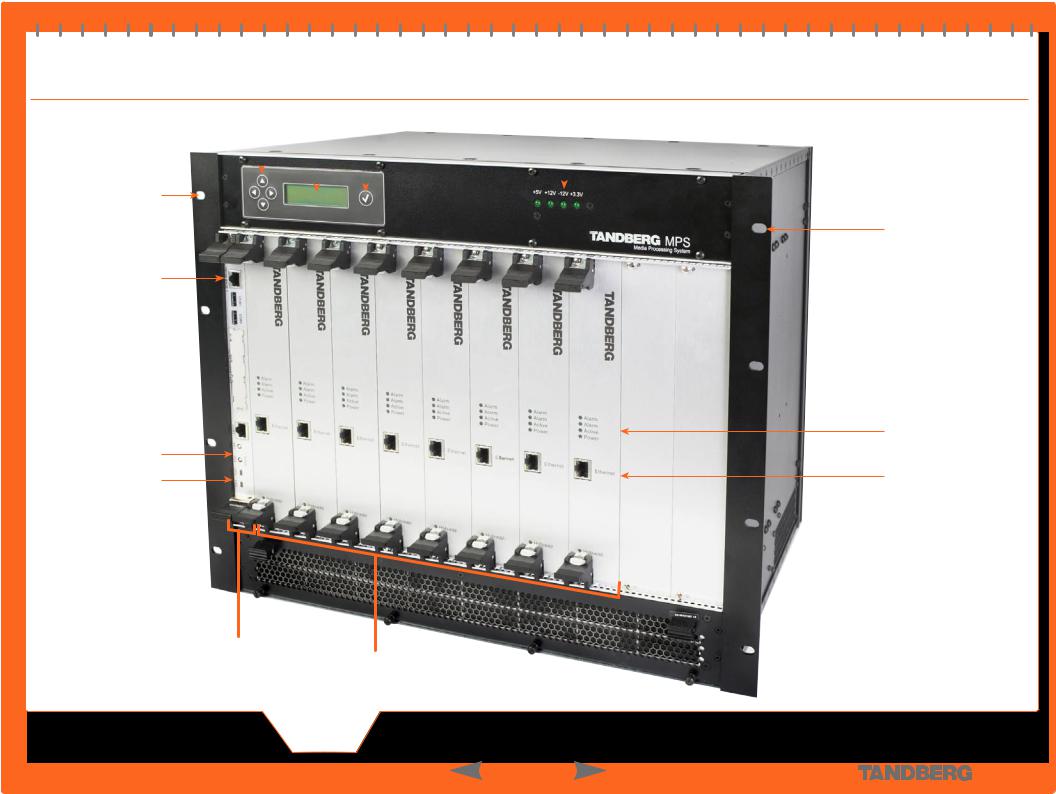
Installation
MPS 800 with 8 Media Processing Cards - Front Side
TANDBERG MPS ADMINISTRATOR GUIDE
Use Arrow keys to |
Display |
Enter/OK key |
LEDs for |
||
navigate in the menu |
|
|
|
|
power status |
|
|
|
|
||
|
|
|
|
|
|
|
|
|
|
|
|
|
|
|
|
|
|
Screw holes for
Rack Mounting
10/100 BASE T
USB 0, USB 1 
PCI Mezzanine Card 
COM1 
RESET button
LEDs for CPU and FAILURE
Screw holes for
Rack Mounting
LEDs for the media board
Ethernet Connectors
|
System Controller |
|
|
|
|
|
|
|
|
|
||
|
Board (in slot 1) |
8 Media Processing |
|
|
|
|
|
|
|
|||
|
|
|
Boards |
|
|
|
|
|
|
|
|
|
Main |
Introduction |
Installation |
Quick |
Using |
System |
System |
Gateway |
MCU |
Technical |
Appendices |
||
Setup |
the MPS |
Status |
Configuration |
Configuration |
Configuration |
Descriptions |
||||||
|
|
|
|
|
||||||||
D 13373.08 |
|
|
|
|
|
23 |
|
|
|
|
MPS |
|
NOVEMBER 2007 |
|
|
|
|
|
|
|
|
|
|||
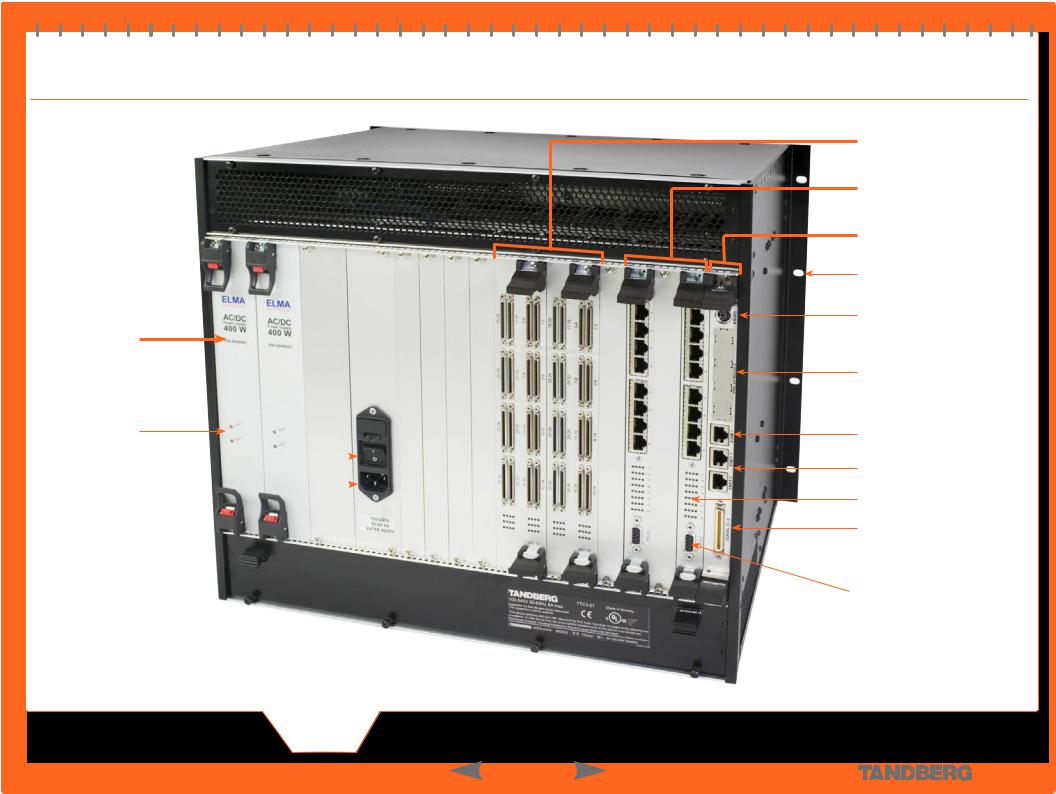
Installation
MPS 800 with ISDN and V.35 Network Cards - Rear Side
TANDBERG MPS ADMINISTRATOR GUIDE
2 Power Supply units (hot swap-
Power Supply
LEDs
Power Switch 
On/Off
AC Power Inlet 
2 V.35 Serial
Interface Cards
2 PRI E1/T1 ISDN Network Interface Cards
System Controller
Board (slot 1)
Bracket for Rack Mounting (in front)
*KB/MS (keyboard/mouse)
*PMC I/O Module
COM1
ENET 1
ENET 2
LEDs for E1/T1 Line 1-8
Serial 3/4
RS232 Serial
Interface
Main |
Introduction |
Installation |
Quick |
Using |
System |
System |
Gateway |
MCU |
Technical |
Appendices |
|
Setup |
the MPS |
Status |
Configuration |
Configuration |
Configuration |
Descriptions |
|||||
|
|
|
|
||||||||
D 13373.08 |
|
|
|
|
24 |
|
|
|
|
MPS |
|
NOVEMBER 2007 |
|
|
|
|
|
|
|
|
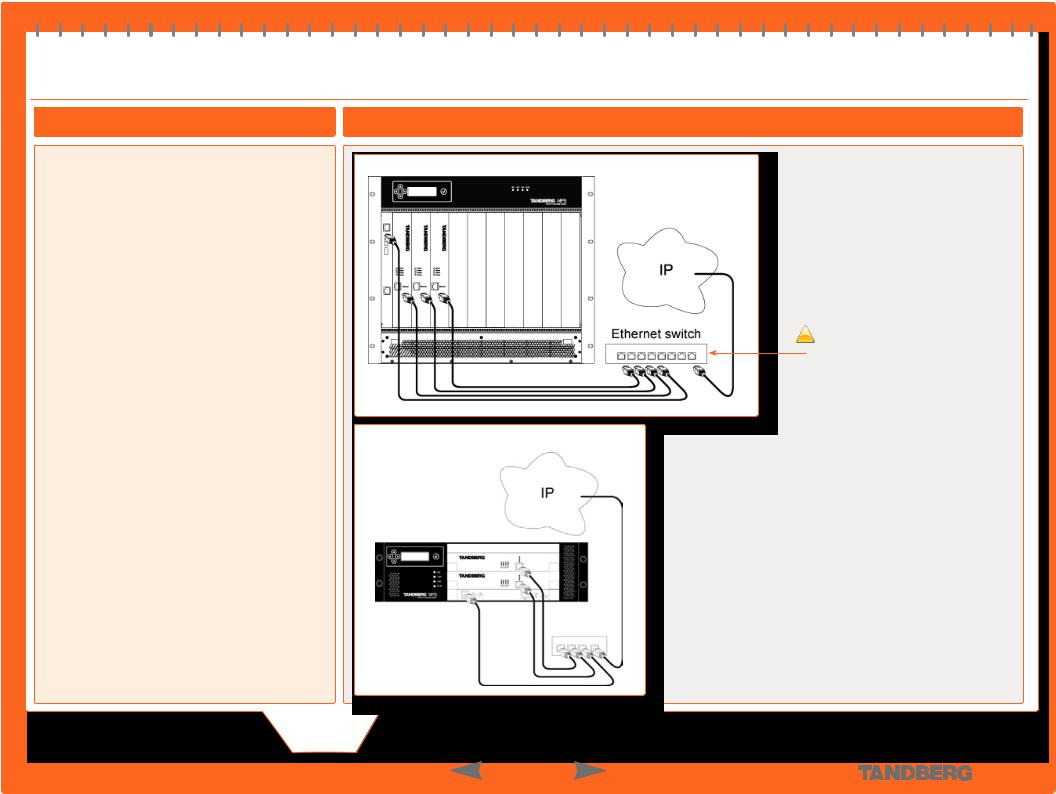
Installation
Connecting Cables
TANDBERG MPS ADMINISTRATOR GUIDE
Connecting Cables
Power Cable
Connect the system power cable to an electrical distribution socket.
LAN Cables
Connect the LAN cable from the 10/100 BASE T connector on the front of the System Controller Board to your network.
From the Ethernet connector on the front of each of the Media Processing Boards, connect a LAN cable to your network.
NOTE: Use a switch/router and not a hub for connecting LAN cables between the TANDBERG MPS and the rest of your network
Connect to Two Separate IP Networks
If you want to connect the TANDBERG MPS to two separate IP networks you must use the second ‘Enet2’ interface on the back of the System Controller Board, in addition to the ‘Enet1’ interface on the front side.
ISDN-PRI Cables
For each of the PRI interfaces, the E1/T1 cable should be connected to a CSU (Channel Service Unit). You will need a CSU between the TANDBERG MPS and the PRI line from your network provider.
NOTE: Both Leased E1/T1 (G.703) and ISDN PRI uses the same physical interface on the ISDN Interface Card.
V.35 Cables
Connect the high-density connector on the V.35 card and insert the TANDBERG standard V.35 connectors (26pin DSUB) into the corresponding position in the 19” rackmountable panel. Additional cables will be required for connection to customer provided device.
See the Technical Description section for further details on the V.35 cables.
Connecting Ethernet Cables
MPS 800 - Connecting Ethernet Cables
MPS 200 - Connecting Ethernet Cables
Do not use a hub!
! Use a switch/router and not a hub for connecting LAN cables between the TANDBERG MPS and the rest of your network.
Main |
Introduction |
Installation |
Quick |
Using |
System |
System |
Gateway |
MCU |
Technical |
Appendices |
|
Setup |
the MPS |
Status |
Configuration |
Configuration |
Configuration |
Descriptions |
|||||
|
|
|
|
||||||||
D 13373.08 |
|
|
|
|
25 |
|
|
|
|
MPS |
|
NOVEMBER 2007 |
|
|
|
|
|
|
|
|
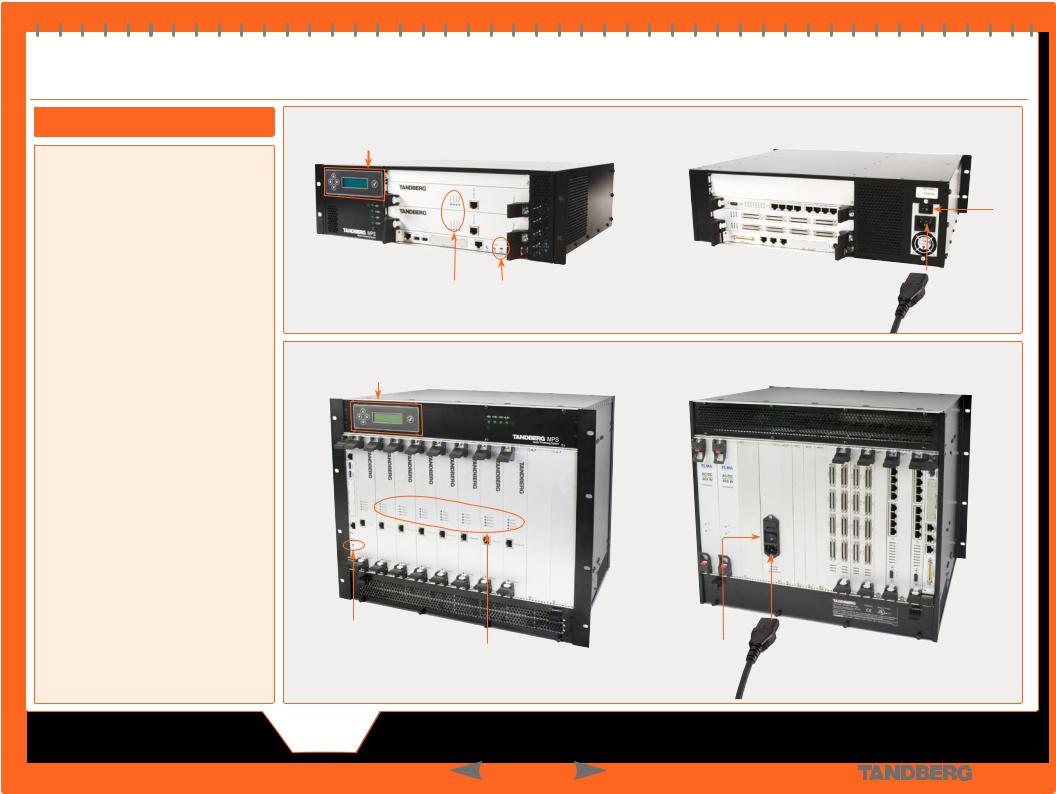
Installation
Starting the System
TANDBERG MPS ADMINISTRATOR GUIDE
Starting the System
Preparations
Before starting the TANDBERG MPS make sure the following has been done:
1.The System Controller Board must be installed in the first slot in the chassis.
2.Make sure the Media Processing Board(s) and the Network Interface Card(s) are interted correctly into the chassis.
2.MPS 800: Make sure the Power Unit(s) are inserted correctly into the back of the chassis.
3.Connect the Power Cable.
Turning on the MPS
Set the Power Switch on the back of the chassis to 1.
Startup mode
•On the front of the chassis you will see the CPU LED on the System Controller Board flashing
•On the Media Processing Boards the Power LED turns green.
•The Active LED is flashing green while software is being uploaded to the Media Processing Boards.
•In the LCD (Liquid Crystal Display) you will see the 


 logo.
logo.
The system is ready for configuration
1.When both Power and Active LED’s on the Media Processing Boards are steady green
2.And the initial configuration menu appears on the LCD.
Main |
Introduction |
D 13373.08
NOVEMBER 2007
MPS200 Front Side
Liquid Crystal
Display
Power LED |
CPU LED |
Active LED |
|
Liquid Crystal
Display
CPU LED
Installation |
Quick |
|
Setup |
||
|
MPS800 Front Side
Power LED
Active LED
Using
the MPS
26
MPS200 Back Side
Power
Switch
Power
Cable
MPS800 Back Side
Switch
Power
Cable
System |
System |
Gateway |
MCU |
Technical |
Appendices |
|
Status |
Configuration |
Configuration |
Configuration |
Descriptions |
||
|
||||||
|
|
|
|
|
MPS |
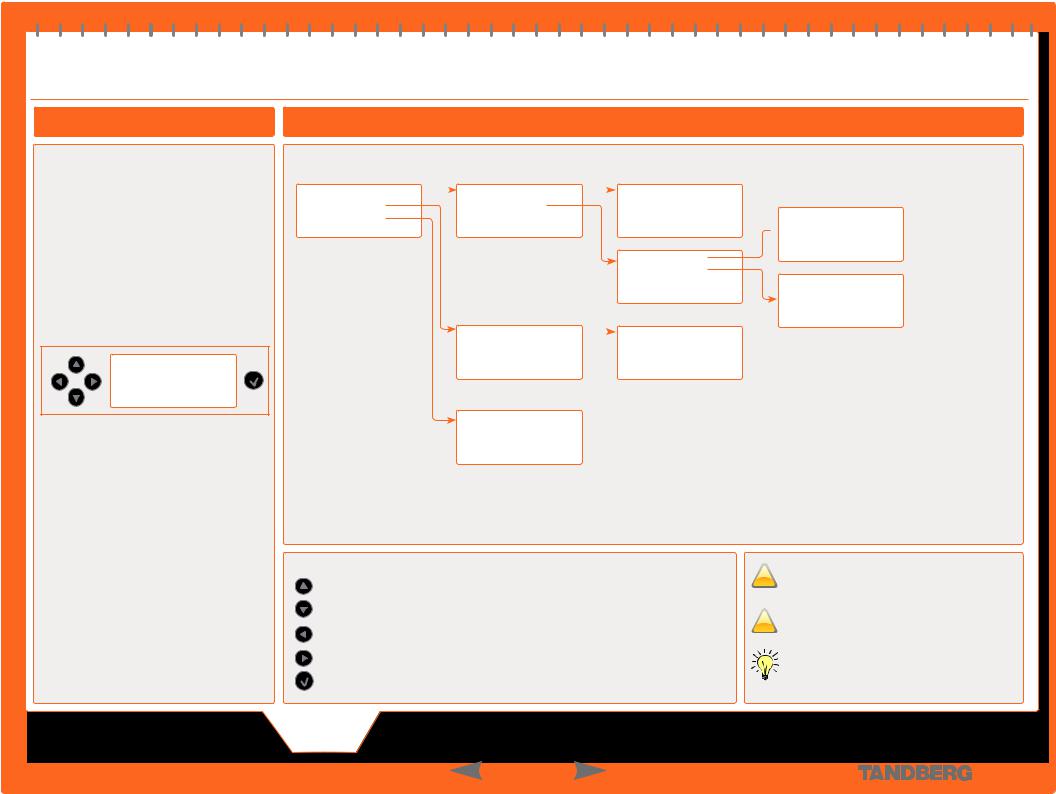
Initial Configuration
LCD Menu Structure
TANDBERG MPS ADMINISTRATOR GUIDE
LCD - Menus
LCD - Liquid Crystal Display
The initial configuration is done through the Liquid Crystal Display (LCD) on the front of the chassis.
Status Page
Conf - number of active conferences Part - number of active participants
IP SC Link - system controller ethernet link indicator
IP Media Link - media card ethernet link indicator
Conf: 0 Part: 0
IP SC Link: Up
IP Media Link: 2/2
Example with a MPS having 2 Media boards
LCD - Menu Structure
Example of the LCD menu structure on a MPS having 1 System Controller Board and 2 Media Processing Boards:
Parameter Config |
|
SC IP Config |
|
IP <192.168.001.100> |
|
|
|||
Parameter Info |
|
Media IP Config |
|
SNM <255.255.255.000> |
LCD Settings |
|
|
|
GW <192.168.001.001> |
Restart |
|
|
|
IF Speed <100Full> |
|
|
|
|
Media 1 IP Config |
|
|
|
|
Media 2 IP Config |
|
|
SC IP Info |
|
IP <192.168.100.101> |
|
|
|
||
|
|
|
|
SNM <255.255.255.000> |
|
|
|
|
GW <192.168.100.001> |
|
|
|
|
IF Speed <100Full> |
|
|
Contrast: 128 |
|
|
|
|
Backlight: On |
|
|
IP <192.168.001.200>  SNM <255.255.255.000> GW <192.168.001.001>
SNM <255.255.255.000> GW <192.168.001.001>
IF Speed <100Full>
IP <192.168.001.300> SNM <255.255.255.000> GW <192.168.001.001> IF Speed <100Full>
IF Speed <Auto/10Half/10F ull/100Half/100Full>
Parameter Configuration
The initial configuration of the MPS needs to be done through the LCD. The initial configuration is done in the Parameter Config menus.
Parameter Info
The configuration can be viewed from the Parameter Info menu.
LCD Settings
The LCD can be configured to control the Contrast and Backlight.
Restart
Select Restart to restart the MPS.
LCD buttons
Press Arrow Up to move up in the menu or to increase a digit (0 –> 9)
Press Arrow Down to move down in the menu or to decrease a digit (9 –> 0)
Press Arrow Left to step back in the menu or to move the next digit to the left
Press Arrow Right to step forward in the menu or to move the next digit to the right
Press Confirm button to confirm a selection
!matically saved.
If Contrast is set to a very low or a very high
!value the display will become black.Take care! When changing a value it is auto-
Restart To activate changes to the Parameter Config the MPS requires a restart.
Main |
Introduction |
Installation |
Quick |
Using |
System |
System |
Gateway |
MCU |
Technical |
Appendices |
|
Setup |
the MPS |
Status |
Configuration |
Configuration |
Configuration |
Descriptions |
|||||
|
|
|
|
||||||||
D 13373.08 |
|
|
|
|
27 |
|
|
|
|
MPS |
|
NOVEMBER 2007 |
|
|
|
|
|
|
|
|
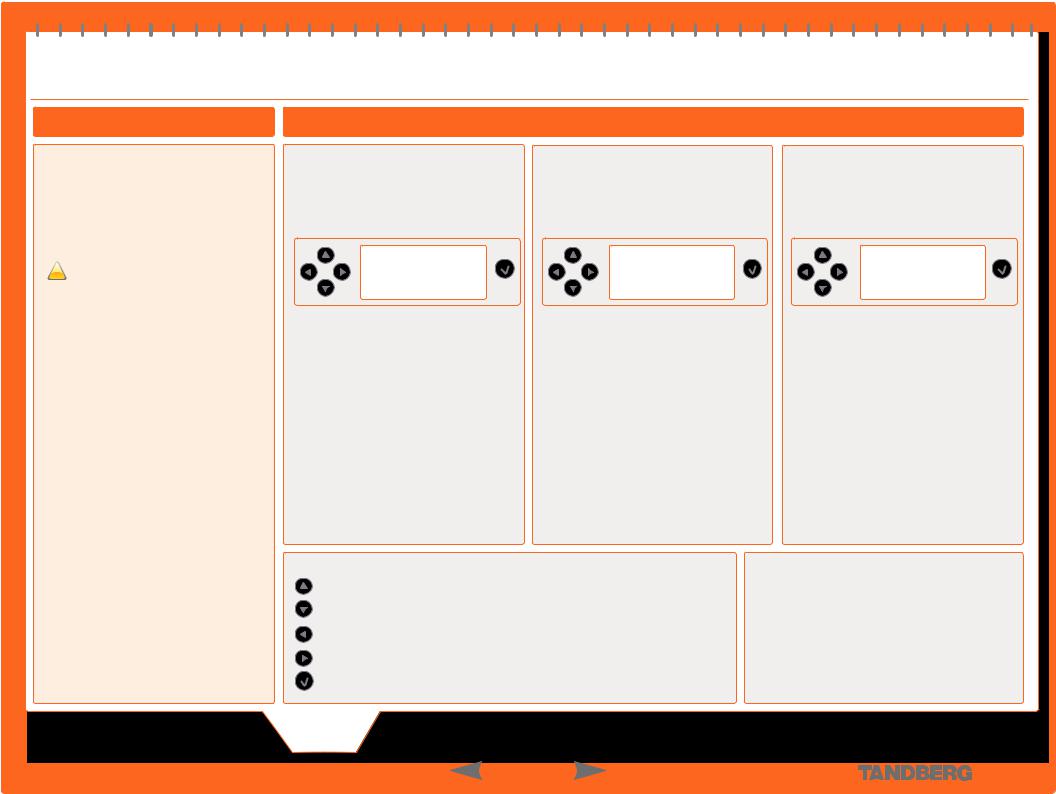
Initial Configuration
System Controller Board - Parameter Configuration
TANDBERG MPS ADMINISTRATOR GUIDE
Initial Configuration |
Parameter Configuration |
LCD
Before using the TANDBERG MPS it requires some basic configuration. This is done through the Liquid Crystal Display (LCD) on the front of the chassis.
Preparing the MPS
Follow the instructions in the Start-
!ing the System section to prepare the system for configuration.
Static Network Addresses
Follow the instructions, to the right, to configure static network addresses and Ethernet speed of the System Controller Board (SC) and the Media Processing Board.
Access to the MPS
After configuring the IP-address of the System Controller Board (and restart the MPS), you may continue the configuration from the web interface. You have access to the TANDBERG MPS by entering the IP-address of the System Controller Board in a standard Web-browser.
Enter Password
You will be asked to enter a password. The Internet Explorer 7 requires a User Name to be entered. Could be such as ‘admin’. The default password for the TANDBERG MPS is “TANDBERG”. The password is case sensitive.
Change Password
To change the password of the system, you need to log into the Command Line Interface. For information please see the TANDBERG MPS API document supplied with the system or on www.tandberg.com.
Main |
Introduction |
D 13373.08
NOVEMBER 2007
•Press any key to open the main menu.
•Use Arrow buttons to select from the submenu and press the Confirm button.
Parameter Config
Parameter Info
LCD Settings
Restart
Parameter Config - Configuration of System Controller Board(s) and Media Processing Board(s).
Parameter Info - See the configuration of the System Controller Board(s) and Media Processing Board(s).
LCD Settings - Configuration of the LCD.
Restart - Restart the MPS
Use Arrow buttons to select SC IP Config and press the Confirm button.
SC IP Config
Media IP Config
SC IP Config - Configuration of the System
Controller Board.
Use Arrow buttons to select a line and set the three addresses and the Ethernet speed. Use Arrow Left to step back in the menu.
IP <192.168.001.100>
SNM <255.255.255.000>
GW <192.168.001.001>
IF Speed <100Full>
IP: Defines the static IP address of the System Controller Board: Example <192.168.001.100>
SNM: Defines the static IP Subnet Mask for the network: Example <255.255.255.000>
GW: Defines the static IP Gateway address: Example <192.168.001.001>
IF Speed: Defines the Ethernet speed: <Auto/
10Half/10Full/100Half/100Full>
LCD buttons
Press Arrow Up to move up in the menu or to increase a digit (0 –> 9)
Press Arrow Down to move down in the menu or to decrease a digit (9 –> 0)
Press Arrow Left to step back in the menu or to move the next digit to the left
Press Arrow Right to step forward in the menu or to move the next digit to the right
Press Confirm button to confirm a selection
Restart the TANDBERG MPS
To activate changes to the Parameter Configuration the MPS requires a restart.
•Use Arrow Left to step back to the main menu and select Restart
Installation |
Quick |
Using |
System |
System |
Gateway |
MCU |
Technical |
Appendices |
|
Setup |
the MPS |
Status |
Configuration |
Configuration |
Configuration |
Descriptions |
|||
|
|
||||||||
|
|
28 |
|
|
|
|
|
MPS |
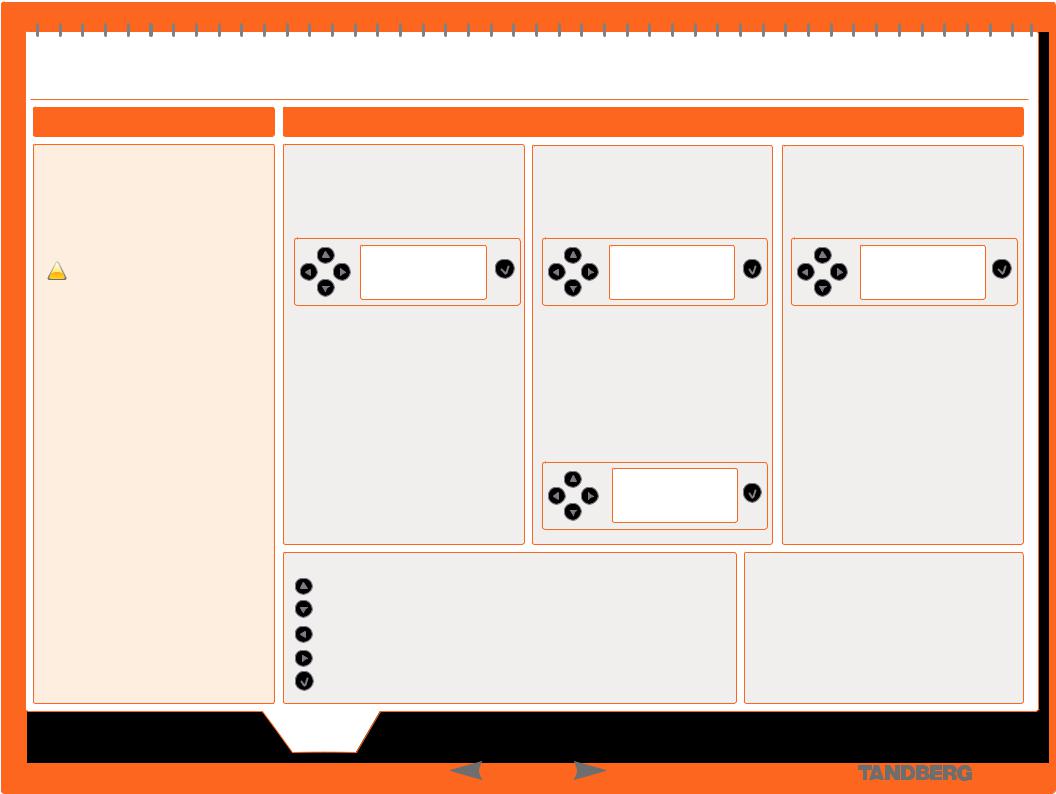
Initial Configuration
Media Processing Board - Parameter Configuration
TANDBERG MPS ADMINISTRATOR GUIDE
Initial Configuration |
Parameter Configuration |
LCD
Before using the TANDBERG MPS it requires some basic configuration. This is done through the Liquid Crystal Display (LCD) on the front of the chassis.
Preparing the MPS
Follow the instructions in the Start-
!ing the System section to prepare the system for configuration.
Static Network Addresses
Follow the instructions, to the right, to configure static network addresses and Ethernet speed of the System Controller Board (SC) and the Media Processing Board.
Access to the MPS
After configuring the IP-address of the System Controller Board (and restart the MPS), you may continue the configuration from the web interface. You have access to the TANDBERG MPS by entering the IP-address of the System Controller Board in a standard Web-browser.
Enter Password
You will be asked to enter a password. The Internet Explorer 7 requires a User Name to be entered. Could be such as ‘admin’. The default password for the TANDBERG MPS is “TANDBERG”. The password is case sensitive.
Change Password
To change the password of the system, you need to log into the Command Line Interface. For information please see the TANDBERG MPS API document supplied with the system or on www.tandberg.com.
Main |
Introduction |
D 13373.08
NOVEMBER 2007
•Press any key to open the main menu.
•Use Arrow buttons to select from the submenu and press the Confirm button.
Parameter Config
Parameter Info
LCD Settings
Restart
Parameter Config - Configuration of System Controller Board(s) and Media Processing Board(s).
Parameter Info - See the configuration of the System Controller Board(s) and Media Processing Board(s).
LCD Settings - Configuration of the LCD.
Restart - Restart the MPS
|
|
Use Arrow buttons to select Media IP Config |
Use Arrow buttons to select a line and set the |
and press the Confirm button. |
three addresses and the Ethernet speed. Use |
|
Arrow Left to step back in the menu. |
SC IP Config
Media IP Config
Media IP Config - Configuration of the Media Processing Board (MPS 200 having 1-2 boards and MPS 800 having 1-8 boards).
If more than one Media board the menu will be extended with the number of boards installed. Use Arrow buttons to select the desired board and continue the configuration.
Media 1 IP Config
Media 2 IP Config
IP <192.168.001.200>
SNM <255.255.255.000>
GW <192.168.001.001>
IF Speed <100Full>
IP: Defines the static IP address of the Media Processing Board: Example <192.168.001.200>
SNM: Defines the static IP Subnet Mask for the network: Example <255.255.255.000>
GW: Defines the static IP Gateway address: Example <192.168.001.001>
IF Speed: Defines the Ethernet speed: <Auto/
10Half/10Full/100Half/100Full>
LCD buttons
Press Arrow Up to move up in the menu or to increase a digit (0 –> 9)
Press Arrow Down to move down in the menu or to decrease a digit (9 –> 0)
Press Arrow Left to step back in the menu or to move the next digit to the left
Press Arrow Right to step forward in the menu or to move the next digit to the right
Press Confirm button to confirm a selection
Restart the TANDBERG MPS
To activate changes to the Parameter Configuration the MPS requires a restart.
•Use Arrow Left to step back to the main menu and select Restart
Installation |
Quick |
Using |
System |
System |
Gateway |
MCU |
Technical |
Appendices |
|
Setup |
the MPS |
Status |
Configuration |
Configuration |
Configuration |
Descriptions |
|||
|
|
||||||||
|
|
29 |
|
|
|
|
|
MPS |
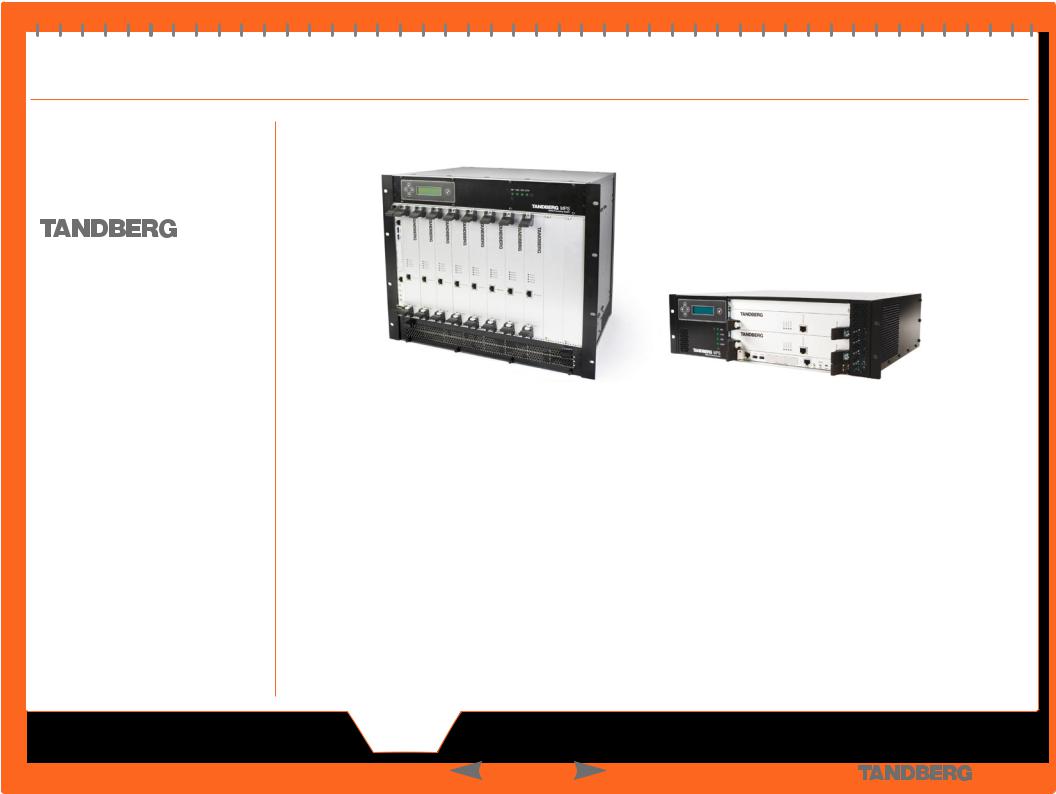
TANDBERG MPS ADMINISTRATOR GUIDE
MPS 200 MPS 800
We recommend that you check the TANDBERG web site regularly for updated versions of this manual:
http://www.tandberg.com/support/ documentation.php
Quick Setup of the MPS
The Quick Setup section will help you get your MPS online and operational quickly. It provides a step-by-step guide to the basic H.323 services setup via the MPS web interface. Please note that as a security precaution, you should change the administrative password at setup time and before the MPS is used in production.
Main |
Introduction |
Installation |
Quick |
Using |
System |
System |
Gateway |
MCU |
Technical |
Appendices |
Setup |
the MPS |
Status |
Configuration |
Configuration |
Configuration |
Descriptions |
||||
D 13373.08 |
|
|
|
30 |
|
|
|
|
|
MPS |
NOVEMBER 2007 |
|
|
|
|
|
|
|
|
